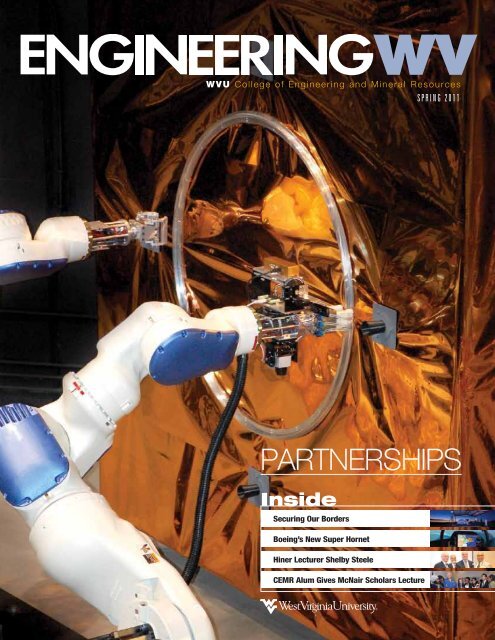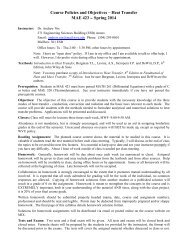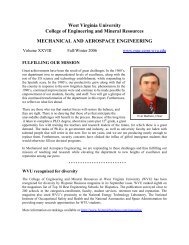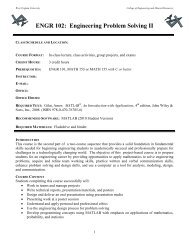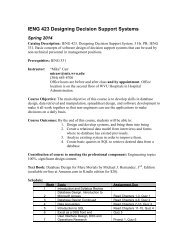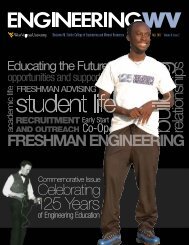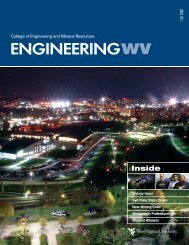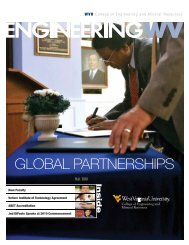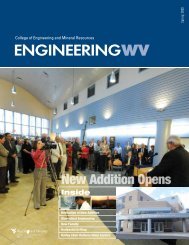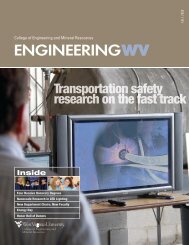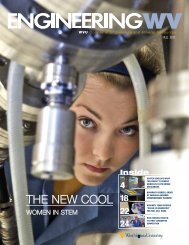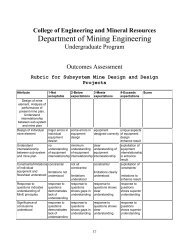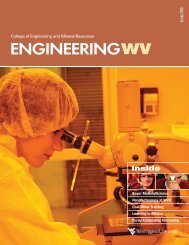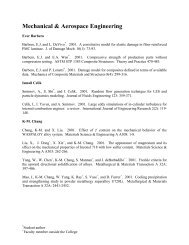2011 Spring - WVU College of Engineering and Mineral Resources ...
2011 Spring - WVU College of Engineering and Mineral Resources ...
2011 Spring - WVU College of Engineering and Mineral Resources ...
You also want an ePaper? Increase the reach of your titles
YUMPU automatically turns print PDFs into web optimized ePapers that Google loves.
Message from the DeanDear Friends:“By 2020, West Virginia University will grow in nationalresearch prominence, thereby enhancing educationalattainment, global engagement, diversity, <strong>and</strong> the vitality<strong>and</strong> well-being <strong>of</strong> the people <strong>of</strong> West Virginia.”positions will work in partnership with colleagues in othercolleges across the University campus in an effort t<strong>of</strong>oster creative activity <strong>and</strong> innovation in several areas,including energy <strong>and</strong> bioengineering.<strong>Spring</strong> <strong>2011</strong> ENGINEERINGWV2The mission <strong>of</strong> the <strong>WVU</strong> <strong>College</strong> <strong>of</strong><strong>Engineering</strong> <strong>and</strong> <strong>Mineral</strong> <strong>Resources</strong>is to prepare students to practicetheir pr<strong>of</strong>ession <strong>and</strong> to contributeto the well-being <strong>of</strong> societythrough academic study, research,extension, <strong>and</strong> service.This vision statement, taken from the 2020 StrategicPlan for the Future as outlined by <strong>WVU</strong> President JamesP. Clements, Ph.D., in January <strong>2011</strong>, sets the stagefor an exciting time in the future <strong>of</strong> the University <strong>and</strong>the <strong>College</strong> <strong>of</strong> <strong>Engineering</strong> <strong>and</strong> <strong>Mineral</strong> <strong>Resources</strong>. Thegoals <strong>of</strong> the strategic plan, especially as they relate toresearch activities in the STEM disciplines (science,technology, engineering, mathematics), innovation,mentorship, <strong>and</strong> partnership are hallmarks <strong>of</strong> the <strong>College</strong>.In this issue <strong>of</strong> <strong>Engineering</strong>WV, you will see howresearchers in biometrics are working in partnershipwith institutions across the country to help secure ourborders. Innovative modeling techniques developed at<strong>WVU</strong> using artificial intelligence <strong>and</strong> data mining arehelping drilling companies optimize production from theMarcellus shale. And the research done as part <strong>of</strong> the<strong>College</strong>’s partnership with NASA through the Centerfor the Robotic Servicing <strong>of</strong> Orbital Space Assets willhelp support future Goddard Space Flight-related spaceexploration issues.While we are proud <strong>of</strong> our achievements, there is stillmuch to be done.As part <strong>of</strong> the 2020 Strategic Plan, <strong>WVU</strong> will fund30 new tenure track faculty positions next year instrategically placed research areas. We are awaiting wordon what we hope will be a number <strong>of</strong> these positionsbeing awarded to the <strong>College</strong>. Many <strong>of</strong> our proposedThis influx <strong>of</strong> new faculty brings vibrancy to the <strong>College</strong>.Two examples <strong>of</strong> this vibrancy, Drs. David Klinke <strong>and</strong>Brian Anderson, assistant pr<strong>of</strong>essors <strong>of</strong> chemicalengineering, are featured in this issue. Klinke is therecipient <strong>of</strong> a CAREER award from the National ScienceFoundation (NSF), which is given to junior facultywho exemplify the role <strong>of</strong> teacher-scholars. Andersonwas selected to participate in a national symposiumfocused on ways to ensure students learn engineeringfundamentals. <strong>WVU</strong> received a $3.2 million grant fromthe NSF ADVANCE Program last fall to help increase thenumber <strong>of</strong> women in the STEM disciplines. CEMR is anactive participant in this initiative.Our number one goal remains unchanged: to engageundergraduate, graduate, <strong>and</strong> pr<strong>of</strong>essional students ina challenging educational <strong>and</strong> research environment.Kerri Phillips, Zack Mayes, Eric Jobe, <strong>and</strong> Andrew Garrettare but a few examples <strong>of</strong> the quality <strong>of</strong> student beingeducated by our faculty. They will soon become CEMRalumni who are among the nation’s leaders in careerreadiness. Someday, we hope they will return to campuslike Bret Marks, William Poundstone, William McCartney,Jon Hammock, Jon McBride, <strong>and</strong> others to share theirexperiences with our students.Eugene V. Cilento, Glen H. Hiner Dean <strong>and</strong> Pr<strong>of</strong>essor
<strong>WVU</strong> COllEGE OF ENGINEERING AND MINERAl RESOURCESFEATURESCOntentsNews from the <strong>WVU</strong> <strong>College</strong> <strong>of</strong> <strong>Engineering</strong> <strong>and</strong> <strong>Mineral</strong> <strong>Resources</strong>4 Researchers Use Artificial Intelligence toOptimize Marcellus Shale Production8 next Level ... Boeing’s New Super HornetInternational Roadmap Exp<strong>and</strong>s theCapability Spectrum12 wvU <strong>and</strong> NASA Partner to Provide Economic<strong>and</strong> Educational Opportunities13 chinese Delegation Visits <strong>WVU</strong> to StudyMine Safetypage 223 nationally Recognized Diversity ExpertDelivers Hiner LectureIN EVERY ISSUEDEAN’S MESSAGEFACULTY/RESEARCH NEWSACCOLADESCOLLEGE NEWSALUMNI NEWSSUPPORTpage 13ON COVER / A robotic arm, equipped with vision <strong>and</strong> touch sensors, can positionitself independently to grapple <strong>and</strong> dock with a satellite, allowing for refueling <strong>and</strong>repair. The research is being performed at the <strong>WVU</strong> Robotics Center as part <strong>of</strong>NASA’s Space Servicing Capabilities Project.SPRING <strong>2011</strong>Dean <strong>and</strong> Publisher / Eugene V. Cilentogene.cilento@mail.wvu.edu / 304.293.4157Editor / Mary C. Dillon / mary.dillon@mail.wvu.eduContributing Writers / Lindsay Bailey / Philip Carder / Betty Mei /Cate Mihelic / Deborah Miller / Nicole RigglemanMagazine Design Coordinator / J. Paige NesbitAddress<strong>WVU</strong> <strong>College</strong> <strong>of</strong> <strong>Engineering</strong> <strong>and</strong> <strong>Mineral</strong> <strong>Resources</strong>Development Office / PO Box 6070 / Morgantown, WV 26506-6070www.cemr.wvu.eduChange <strong>of</strong> Address<strong>WVU</strong> Foundation / PO Box 1650Morgantown, WV 26504-1650Fax: 304.284.4001 / e-mail: info@wvuf.orgwww.mountaineerconnection.com<strong>Engineering</strong> West Virginia is published twice each year, in spring <strong>and</strong> fall, for the alumni,friends, <strong>and</strong> other supporters <strong>of</strong> the <strong>WVU</strong> <strong>College</strong> <strong>of</strong> <strong>Engineering</strong> <strong>and</strong> <strong>Mineral</strong> <strong>Resources</strong>.Copyright ©<strong>2011</strong> by the <strong>WVU</strong> <strong>College</strong> <strong>of</strong> <strong>Engineering</strong> <strong>and</strong> <strong>Mineral</strong> <strong>Resources</strong>. Brief excerpts<strong>of</strong> articles in this publication may be reprinted without a request for permission if <strong>Engineering</strong>West Virginia is acknowledged in print as the source. Contact the Editor for permission toreprint entire articles.West Virginia University is governed by the <strong>WVU</strong> Board <strong>of</strong> Governors <strong>and</strong> the West VirginiaHigher Education Policy Commission. <strong>WVU</strong> is an Equal Opportunity/Affirmative Action Institution.page 21page 26Volume 7 Issue 11
Faculty ReseaRChResearchers use artificialoptimize Marcellus shaleproductionBy Mary C. DillonThe Marcellus shale, an immense stretch <strong>of</strong> rock that runs deepunderground through parts <strong>of</strong> Pennsylvania, New York, Ohio, <strong>and</strong> WestVirginia, is rich in natural gas. Scientists have known about the formationfor a long time, but it wasn’t until recently that they realized it couldbe one <strong>of</strong> the largest-known natural gas fields in the world. A grant for$353,934 from the Gas Technology Institute (GTI) will enable researcherswith West Virginia University’s <strong>College</strong> <strong>of</strong> <strong>Engineering</strong> <strong>and</strong> <strong>Mineral</strong><strong>Resources</strong> to use data-intensive science to optimize gas production inthe region.Dr. Shahab Mohaghegh, a pr<strong>of</strong>essor in<strong>WVU</strong>’s Department <strong>of</strong> Petroleum <strong>and</strong> NaturalGas <strong>Engineering</strong>, is leading a team <strong>of</strong>researchers in applying the latest technologyto reservoir modeling. Mohaghegh isa pioneer in the application <strong>of</strong> artificialintelligence <strong>and</strong> data mining (AI&DM) in thepetroleum industry.<strong>Spring</strong> <strong>2011</strong> ENGINEERINGWV“Traditionally, in order to increase productionDr. Shahab Mohagheghyou would build a predictive reservoir modelusing conventional technology,” Mohaghegh said. “The technology weare using is new <strong>and</strong> unconventional. It is not based on physics <strong>and</strong>mathematics, but on ‘top-down’ modeling.”Conventional reservoir simulation <strong>and</strong> modeling is a bottom-up approach.It starts with building a geological model <strong>of</strong> the reservoir that is populatedwith the best petrophysical <strong>and</strong> geophysical information available at thetime <strong>of</strong> development. <strong>Engineering</strong> fluid flow principles are then added<strong>and</strong> solved numerically to arrive at a dynamic reservoir model. Themodel is calibrated using the production history <strong>of</strong> multiple wells, <strong>and</strong> thehistory-matched model is used to strategize field development in order toimprove recovery.4
<strong>WVU</strong> COllEGE OF ENGINEERING AND MINERAl RESOURCESintelligence toAlums named toMarcellus task forceAccording to Mohaghegh, top-down, intelligent reservoir modelingapproaches the reservoir simulation <strong>and</strong> modeling from the oppositeangle. It integrates traditional reservoir engineering analysis with AI&DMtechnology to generate a full-field model. Using this new technologyleads to savings <strong>of</strong> both time <strong>and</strong> research resources to obtain accuratepredictive models. Over time, more wells <strong>and</strong> more historical dataenhance the results <strong>of</strong> the model.“This is very new technology that has been extensively <strong>and</strong> exclusivelyused here at <strong>WVU</strong>,” Mohaghegh said. “People in the industry are quiteinterested to see how our research in this area progresses.”GTI is a nonpr<strong>of</strong>it organization with more than 65 years <strong>of</strong> experience inthe development <strong>and</strong> deployment <strong>of</strong> technology solutions that contributeto a secure, abundant, <strong>and</strong> affordable energy future. GTI programshave resulted in nearly 500 products, 750 licenses <strong>and</strong> more than 1,200associated patents.Funding for the project is provided through the Ultra-Deepwater <strong>and</strong>Unconventional Natural Gas <strong>and</strong> Other Petroleum <strong>Resources</strong> Research<strong>and</strong> Development Program, authorized by the Energy Policy Act <strong>of</strong>2005. This program—funded from lease bonuses <strong>and</strong> royalties paid byindustry to produce oil <strong>and</strong> gas on federal l<strong>and</strong>s—is specifically designedto increase supply <strong>and</strong> reduce costs to consumers while enhancingthe global leadership position <strong>of</strong> the United States in energy technologythrough the development <strong>of</strong> domestic intellectual capital.The Research Partnership to Secure Energy for America (RPSEA) isunder contract with the U.S. Department <strong>of</strong> Energy’s National EnergyTechnology Laboratory to administer several elements <strong>of</strong> the program.RPSEA is a 501(c)(3) nonpr<strong>of</strong>it consortium with more than 180members, including 22 <strong>of</strong> the nation’s premier research universities, sixnational laboratories, other major research institutions, large <strong>and</strong> smallenergy producers, <strong>and</strong> energy consumers. The mission <strong>of</strong> RPSEA,headquartered in Sugar L<strong>and</strong>, Texas, is to provide a stewardship rolein ensuring the focused research, development <strong>and</strong> deployment <strong>of</strong> safe<strong>and</strong> environmentally responsible technology that can effectively deliverhydrocarbons from domestic resources to the citizens <strong>of</strong> the UnitedStates. Additional information can be found at www.rpsea.org.•Gov. Earl Ray Tomblin recentlyannounced the formation <strong>of</strong> a Marcellusto Manufacturing Task Force. The taskforce will research <strong>and</strong> develop potentialeconomic development opportunitiesrelated to Marcellus shale <strong>and</strong> natural gasbyproducts such as ethane <strong>and</strong> ethylene.The 12-member task force includes threealums <strong>of</strong> the <strong>College</strong> <strong>of</strong> <strong>Engineering</strong> <strong>and</strong><strong>Mineral</strong> <strong>Resources</strong>: Greg Babe, president<strong>and</strong> CEO <strong>of</strong> Bayer Corporation <strong>and</strong> BayerMaterials Science LLC; Kevin DiGregorio,executive director, Chemical Alliance ZoneWest Virginia; <strong>and</strong> Michael John, president<strong>and</strong> CEO, Northeast Natural Energy.The task force has been asked to research<strong>and</strong> analyze the feasibility <strong>of</strong> convertingethane to ethylene using thermal or steamcracking; identify potential private-sectorcompanies that specialize in constructing<strong>and</strong> operating thermal or steam crackers<strong>and</strong> develop strategies on how to attractsuch companies; <strong>and</strong> locate existinginfrastructure in the state, includingpipelines <strong>and</strong> storage facilities, which maybe upgraded to be used in conjunction withmanufacturing processes associated withethane, ethylene, <strong>and</strong> other natural gasbyproducts.Volume 7 Issue 15
Faculty ReseaRCh<strong>Spring</strong> <strong>2011</strong> ENGINEERINGWV6<strong>WVU</strong>’s Klinke earnsNational ScienceFoundation CAREERawardAward to Support FundamentalResearch Toward Underst<strong>and</strong>ing howCancer Cells Resist Targeted TherapyBy Mary C. DillonDr. David KlinkeMonoclonal antibody drugs <strong>and</strong> natural killer cells pack a one-two punch in the fight againstcancer. But sometimes, cancer cells escape the therapeutic action <strong>of</strong> these antibodies. A$416,483 Faculty Early Career Development (CAREER) award from the National ScienceFoundation (NSF) will allow West Virginia University’s Dr. David J. Klinke to help determine whysome cancer cells resist these targeted therapies.Klinke, an assistant pr<strong>of</strong>essor <strong>of</strong> chemical engineering in the <strong>College</strong> <strong>of</strong> <strong>Engineering</strong> <strong>and</strong><strong>Mineral</strong> <strong>Resources</strong>, is hoping the fruits <strong>of</strong> his research can improve therapies for cancer, adisease that kills one in three in developed countries.A monoclonal antibody is produced naturally by the body but can also be engineeredcommercially to attach itself to specific molecules displayed on the surface in cancer cells. Bylabeling the cancer cells, they attract natural killer cells, the body’s natural first line <strong>of</strong> defensein attacking tumors <strong>and</strong> virally infected cells, to do their job. “The emergence <strong>of</strong> resistance totargeted therapies is an increasing, <strong>and</strong> poorly understood, problem” said Klinke. “Withouta better underst<strong>and</strong>ing <strong>of</strong> how cancer cells resist the action <strong>of</strong> molecular targeted therapies,designing effective treatments will remain limited.”According to Klinke, the underlying idea he aims to test is that cancer cells fight back; theysecrete biochemical signals that interfere with how natural killer cells recognize <strong>and</strong> destroycancer cells that monoclonal antibodies have labeled. His research, using aspects <strong>of</strong> cellularengineering, immunology, cancer biology, <strong>and</strong> computationally intensive model-basedinference, will attempt to underst<strong>and</strong> this “cross-talk” between cancer cells <strong>and</strong> naturalkiller cells. Klinke is an expert in the emerging field <strong>of</strong> systems biology, a field that integratesmathematical modeling with experimental study to better underst<strong>and</strong> biological systems.“Model-based inference is the process <strong>of</strong> encoding our prior knowledge <strong>of</strong> how cells interpretbiochemical signals in the form <strong>of</strong> a mathematical model,” said Klinke. “We then update ourknowledge by testing whether our prior knowledge is consistent with the experimental data.”The CAREER Program <strong>of</strong>fers the NSF’s most prestigious awards in support <strong>of</strong> junior facultywho exemplify the role <strong>of</strong> teacher-scholars through outst<strong>and</strong>ing research, excellent education,<strong>and</strong> the integration <strong>of</strong> education <strong>and</strong> research within the context <strong>of</strong> the mission <strong>of</strong> theirorganizations.Klinke is affiliated with the Department <strong>of</strong> Microbiology, Immunology, <strong>and</strong> Cell Biology <strong>and</strong>the Mary Babb R<strong>and</strong>olph Cancer Center at <strong>WVU</strong>’s School <strong>of</strong> Medicine. He has authored 30publications <strong>and</strong> holds two patents.•<strong>WVU</strong> researcherpart <strong>of</strong> teamthat correctlyestimates Gulfoil spill numbersThe efforts <strong>of</strong> a researcher in West VirginiaUniversity’s <strong>College</strong> <strong>of</strong> <strong>Engineering</strong> <strong>and</strong> <strong>Mineral</strong><strong>Resources</strong> were confirmed when the Department<strong>of</strong> Energy (DOE) released its report on the amount<strong>of</strong> oil spilled during last year’s Deepwater Horizonoil spill in the Gulf <strong>of</strong> Mexico.Dr. Shahab Mohaghegh, a pr<strong>of</strong>essor in CEMR’sDepartment <strong>of</strong> Petroleum <strong>and</strong> Natural Gas, workedas part <strong>of</strong> the Flow Rate Technology Group’sNodal Analysis Team. The team, led by Dr. GeorgeGuthrie <strong>of</strong> the Department <strong>of</strong> Energy’s NationalEnergy Technology Laboratory, consisted <strong>of</strong>subteams from five DOE national laboratories.According to their estimates, 53,000 barrels perday were escaping as a result <strong>of</strong> the <strong>of</strong>fshoredrilling rig that exploded on April 20, 2010. Forthree months, the resulting leak continued to gush,making it the largest accidental marine oil spill inthe history <strong>of</strong> the petroleum industry.“It was a heroic process,” said Mohaghegh. “Wehad 15 people working on it around the clock.”The Nodal Analysis Team used input from reservoirmodeling (including pressure, temperature,fluid composition, <strong>and</strong> properties over time) <strong>and</strong>pressure <strong>and</strong> temperature conditions at the leakpoints on the sea floor, along with details <strong>of</strong> thegeometries <strong>of</strong> the well, blowout preventer, <strong>and</strong>riser to calculate fluid compositions, properties,<strong>and</strong> fluxes from both before <strong>and</strong> after riserremoval. According to Mohaghegh, the teamused both conventional <strong>and</strong> advanced modelingtechniques, based on artificial intelligence <strong>and</strong>data mining.For his efforts, Mohaghegh was awarded $55,600from the URS Corp. for “Gulf Oil Spill ResponseEffort Support.” The final numbers released by theDepartment <strong>of</strong> Energy were very close to thosecalculated by the research team.
<strong>WVU</strong> COllEGE OF ENGINEERING AND MINERAl RESOURCES<strong>WVU</strong>, NASA EPSCoRcollaborate toconduct researchBy Cate MihelicCollaborating with industry leaders to conduct state-<strong>of</strong>-the-art researchis possible in rural states such as West Virginia because <strong>of</strong> initiativesset forth by NASA EPSCoR.Housed in the West Virginia University <strong>College</strong> <strong>of</strong> <strong>Engineering</strong> <strong>and</strong><strong>Mineral</strong> <strong>Resources</strong>, the NASA Experimental Program to StimulateCompetitive Research, or EPSCoR, establishes partnerships withgovernment, higher education, <strong>and</strong> industry that are designed to effectlasting improvement in a state or region’s research infrastructure,research <strong>and</strong> development capacity, <strong>and</strong> national competitiveness.The NASA EPSCoR Program is directed at jurisdictions that have notparticipated equably in competitive aerospace <strong>and</strong> aerospace-relatedresearch activities. Twenty-seven states <strong>and</strong> the Commonwealth <strong>of</strong>Puerto Rico currently participate.One major component <strong>of</strong> the NASA EPSCoR Program in WestVirginia is competitively won research cooperative agreements thatare designed to strengthen <strong>and</strong> support research activities that areOne such project aims to develop a model for the spray coolingprocess <strong>of</strong> air- or spacecrafts in zero gravity environments. It is apartnership between NASA Goddard Space Flight Center, NASAGlenn Research Center, <strong>and</strong> <strong>WVU</strong>. John Kuhlman, a mechanical<strong>and</strong> aerospace pr<strong>of</strong>essor, is the science principal investigator;Donald Gray, a pr<strong>of</strong>essor in the Civil <strong>and</strong> Environmental <strong>Engineering</strong>Department, is the co-investigator.Another research project being conducted at CEMR involvesunmanned aerial <strong>and</strong> space vehicles with adaptive <strong>and</strong> intelligentflight control systems. These systems will be capable <strong>of</strong> maintainingacceptable levels <strong>of</strong> performance even in the event <strong>of</strong> failures. MarcelloNapolitano, director <strong>of</strong> <strong>WVU</strong>’s Center for Advanced Research inAutonomous Technology, is the science principal investigator. BojanCukic, a co-investigator, is a Robert C. Byrd Associate Pr<strong>of</strong>essor inthe Lane Department <strong>of</strong> Computer Science <strong>and</strong> Electrical <strong>Engineering</strong>.This team has partnered with NASA research centers such asDryden, Ames, <strong>and</strong> Langley, as well as the Department <strong>of</strong> Defense,Department <strong>of</strong> Transportation, <strong>and</strong> the Green Bank Telescope. Thereare six industry partners, <strong>and</strong> the University <strong>of</strong> Virginia, Penn StateUniversity, <strong>and</strong> the University <strong>of</strong> Michigan are involved.In the third project, researchers are working to develop localizedwing morphing technology with smart skins to improve aerodynamicefficiency. Wade Huebsch, a mechanical <strong>and</strong> aerospace pr<strong>of</strong>essor, isthe science principal investigator. His co-investigators include DarranCairns <strong>and</strong> Ever Barbero, both from the Mechanical <strong>and</strong> Aerospace<strong>Engineering</strong> Department. Supporters <strong>of</strong> this research at NASA Langleyhave identified several areas in aeronautics where they hope to see“The partnerships that are formed are beneficial to both parties.”beneficial to the research capabilities <strong>of</strong> the state, as well as advancingNASA’s research priorities. These are three-year competitive grantsfor up to $750,000 <strong>of</strong> federal funds per winning project, supplementedwith cost sharing from the researcher’s home institution. WV NASAEPSCoR currently has five research cooperative agreements withNASA, three <strong>of</strong> which are based at CEMR.“NASA has specific research goals <strong>and</strong> priorities, <strong>and</strong> they chooseto work with universities such as <strong>WVU</strong> to help achieve these goals,”noted Majid Jaraiedi, director <strong>of</strong> NASA WV EPSCoR. “The partnershipsthat are formed are beneficial to both parties.”this technology applied. This project is a collaboration between <strong>WVU</strong><strong>and</strong> industry partners.A second component <strong>of</strong> NASA WV EPSCoR is the ResearchInfrastructure Development Program. This program supplies researchseed grants, travel grants, <strong>and</strong> a college-university collaborationprogram that promotes mentoring roles from <strong>WVU</strong> or Marshall withsmaller colleges in West Virginia.For more information about NASA WV EPSCoR, please visitwww.nasa.wvu.edu.• Volume 7 Issue 17CorrectionIn the fall 2010 issue <strong>of</strong> ENGINEERINGWV, it was incorrectly noted that Lian-Shin Lin,who was promoted to associate pr<strong>of</strong>essor, was in the Lane Department <strong>of</strong> ComputerScience <strong>and</strong> Electrical <strong>Engineering</strong>. Dr. Lin is in the Department <strong>of</strong> Civil <strong>and</strong>Environmental <strong>Engineering</strong>. The editorial staff apologizes for the error.
INDUstRY FEatUREBoeing’s Super Hornet International Roadmap is composed <strong>of</strong> six new advancedoptions that will enable international customers to customize capability basedon their unique requirements. The new options include: enhanced performanceengines; enclosed weapons pod; conformal fuel tanks; missile/laser warningsystem; internal infrared search <strong>and</strong> track system; <strong>and</strong> a next-generation cockpit.(Boeing photo by Ron Bookout)Next Level ... Boeing’sNew Super Hornet<strong>Spring</strong> <strong>2011</strong> ENGINEERINGWVInternational Roadmap Exp<strong>and</strong>s the Capability SpectrumBy Philip Carder, APR, Boeing F/A-18<strong>and</strong> EA-18 Communications8Boeing Test Pilot Ricardo Traven briefs journalists on the new capabilities the Super HornetInternational Roadmap delivers for international tactical aviation customers on February 8, <strong>2011</strong>, atIndia’s Air Force Station Yelahanka during the Aero India <strong>2011</strong> air show. (Boeing photo by Kevin Flynn)
<strong>WVU</strong> COllEGE OF ENGINEERING AND MINERAl RESOURCESAs international air forcesaround the world look for everincreasingcapability to meetnew threats that evolve onan almost daily basis, Boeingis applying an innovativeapproach to meet the needs <strong>of</strong>tactical aviation customers.On February 8 at India’s Air Force Station Yelahanka, locatednear the city <strong>of</strong> Bengaluru in the southern Indian state <strong>of</strong>Karnataka, thous<strong>and</strong>s <strong>of</strong> government <strong>and</strong> military <strong>of</strong>ficialsfrom around the globe got their first look at Boeing’s new F/A-18 Super Hornet International Roadmap, an aircraft outfittedwith options designed to give international customers theability to tailor their aircraft to not only defeat today’s threats,but ensure continued air dominance for decades to come.Roadmap to the FutureIn architecting the Super Hornet International Roadmap,Boeing engineers <strong>and</strong> analysts looked deep into the futureto determine what capabilities would deliver a knockoutpunch in tactical air operations in the coming decades. BretMarks, Boeing’s director <strong>of</strong> F/A-18 International Operations,said the team believes it has unearthed a gem with the newSuper Hornet options. “The Super Hornets we currentlyFeaturing a new 11 X 19 inch touchscreen display, Boeing’s next-generation cockpitfor the F/A-18E/F Super Hornet will provide pilots with an interactive 3-D perspective<strong>of</strong> the air <strong>and</strong> ground threat environments. (Boeing photo by Ron Bookout)build in St. Louis are some <strong>of</strong> the most advanced tacticalaircraft produced in the world today,” said Marks. “With theintroduction <strong>of</strong> the International Roadmap, we have providedinternational air forces with the ability to enhance currentSuper Hornet capabilities to best address the unique threatsthey will encounter in their operating environments.”Marks, who earned a bachelor <strong>of</strong> science degree inaeronautical engineering in 1984 from West VirginiaUniversity’s <strong>College</strong> <strong>of</strong> <strong>Engineering</strong> <strong>and</strong> <strong>Mineral</strong> <strong>Resources</strong>,joined Boeing that same year as an engineer in theAerodynamic Technology Applied Research Group. Today,Marks leads Boeing’s F/A-18E/F International Programsunder the Global Strike division, located in St. Louis. “To besuccessful in the international tactical aviation market, youmust underst<strong>and</strong> the core needs <strong>of</strong> your customers,” saidMarks. “Air forces around the world need tactical aircraftthat provide the flexibility to meet current <strong>and</strong> emergingthreats. However, they also need aircraft that are affordable,<strong>and</strong> reliable, with real growth capability to ensure long-termrelevancy.”Evolutionary growthMarks, who has accumulated nearly 27 years <strong>of</strong> engineering<strong>and</strong> program management experience on tactical aircraftprograms at Boeing, said the team in St. Louis is focused onan evolutionary path <strong>of</strong> inserting new, advanced technologiesinto the combat-proven Super Hornet. “What we are doingwith this approach is maximizing capability while minimizingdevelopment risk,” he said. “When we insert these advancedapplications onto a proven platform, like we have in the SuperHornet, we eliminate much <strong>of</strong> the risk that exists with themore revolutionary approach <strong>of</strong> attempting to incorporatenew technology onto new platforms. The result is the ability to<strong>of</strong>fer truly advanced capability, while minimizing developmentcost <strong>and</strong> schedule risks. It’s a best-value approach for ourcustomers.”Six super optionsThe Super Hornet International Roadmap is composed<strong>of</strong> six new advanced options that Marks said will enableinternational customers to customize capability accordingto their needs. “The options deliver increased survivability,situational awareness, aerodynamic performance, <strong>and</strong>provide a compelling value proposition for our internationalcustomers,” said Marks. Specifically, the options include:an internal infrared search <strong>and</strong> track system (IRST); nextgenerationcockpit featuring large area displays; missile/laser warning systems; enclosed weapons pod; enhancedperformance engines; <strong>and</strong> conformal fuel tanks.“The combination <strong>of</strong> internal IRST <strong>and</strong> missile/laser warningsystems provide the war fighter with greater battlespaceawareness,” said Marks. “That’s critical in all combatoperations.” For customers who desire increased power, Markssaid pilots will see a 15 to 20 percent increase in thrust withthe enhanced performance engine.continued...»Volume 7 Issue 19
INDUstRY FEatUREcontinued...» A noticeable addition under the aircraft’s fuselage is theenclosed weapons pod. Able to carry a variety <strong>of</strong> air-to-air <strong>and</strong> airto-groundweapons, Marks said the pod gives operators wide-rangingweapons options for a variety <strong>of</strong> missions, while improving missionperformance <strong>and</strong> increasing overall aircraft survivability.“Another option gaining popularity with the international customercommunity is the next-generation cockpit that features an 11 x 19inch touch screen with the ability to present the pilot with a 3-Dperspective <strong>of</strong> the air <strong>and</strong> ground threat environments,” said Marks.“It’s certainly a stunning feature whose benefits are immediatelyapparent when you climb into the cockpit,” he said. The new displaywill ultimately allow aircrews to move <strong>and</strong> combine images <strong>and</strong>information on the screen via touch screen technology.<strong>Spring</strong> <strong>2011</strong> ENGINEERINGWV10Bret Marks, who earned a bachelor<strong>of</strong> science degree in aeronauticalengineering in 1984 from WestVirginia University’s <strong>College</strong> <strong>of</strong><strong>Engineering</strong> <strong>and</strong> <strong>Mineral</strong> <strong>Resources</strong>,joined Boeing that same year asan engineer in the AerodynamicTechnology Applied Research Group.Today, Marks leads Boeing’s F/A-18E/F International Programs underthe Global Strike division, located inSt. Louis.Bret Marks returned to his alma mater this past fall as part <strong>of</strong>the <strong>College</strong> <strong>of</strong> <strong>Engineering</strong> <strong>and</strong> <strong>Mineral</strong> <strong>Resources</strong> DistinguishedLecture Series. Marks’ lecture, “Mountaineer to Engineer—Livingthe Dream,” detailed his more than 26 years <strong>of</strong> experiencewith Boeing, where he has previously held positions as anaerodynamicist, supplier manager, program manager, Global StrikeFlight Systems Lead, <strong>and</strong> Medium Multi-Role Combat Aircraft F/A18 India program manager. He has published <strong>and</strong> presented anumber <strong>of</strong> technical papers on advanced fighter aircraft controlconcepts, F/A-18 flight control system development, <strong>and</strong> carriersuitability flight test evolution.“To be successful inthe international tacticalaviation market, you mustunderst<strong>and</strong> the core needs<strong>of</strong> your customers.”—Bret Marks, Boeing F/A-18E/F InternationalPrograms director located in St. LouisThe most noticeable option is the new conformal fuel tanks mountedon the aircraft’s dorsal deck. The tanks provide an additional 3,000pounds <strong>of</strong> fuel, without the drag <strong>of</strong> externally mounted fuel tanks,traditionally mounted under the wing. “The conformal fuel tankspermit significant enhancements in aerodynamic performance,”said Marks. “By removing external tanks from under the wing <strong>and</strong>replacing them with conformal fuel tanks designed to maintain anoptimal area rule pr<strong>of</strong>ile, we are able to achieve substantial dragreduction, which directly benefits performance.”Marks said depending on customer requirements, some options couldbe ready for customers by 2015. “One <strong>of</strong> the exciting aspects <strong>of</strong> theInternational Roadmap is that each <strong>of</strong> the six options are retr<strong>of</strong>ittableto current Super Hornets,” he said.“The Super Hornet was designed for growth from its inception,” saidMarks. “As we look across the international l<strong>and</strong>scape, we underst<strong>and</strong>customers need aircraft that are designed to evolve as threats continueto evolve,” he said. “That’s exactly what the International Roadmapoptions deliver—long-term growth <strong>and</strong> evolutionary capability.”•Copyright (c) <strong>2011</strong> Boeing. All rights reserved.
FACUlty NEWS<strong>WVU</strong> COllEGE OF ENGINEERING AND MINERAl RESOURCESCEMR pr<strong>of</strong>essorappointed to ABETaccreditation boardBy Cate MihelicAnother engineering pr<strong>of</strong>essor is reaching outbeyond the classroom <strong>and</strong> making an impacton education <strong>and</strong> the future <strong>of</strong> the industry.Samuel Ameri, chair <strong>and</strong> pr<strong>of</strong>essor <strong>of</strong>petroleum <strong>and</strong> natural gas engineering at West Dr. Samuel AMERIVirginia University, has been appointed toserve on the Accreditation Board for <strong>Engineering</strong> <strong>and</strong> Technology(ABET) board <strong>of</strong> directors.Ameri said that he was humbled <strong>and</strong> surprised by his appointmentto the board <strong>of</strong> directors <strong>of</strong> ABET.“It is my policy <strong>and</strong> vision to ensure that all students continue tostudy in a stimulating, innovative, <strong>and</strong> high-quality environmentin order to gain the best engineering education possible,” saidAmeri. “I am proud <strong>of</strong> <strong>WVU</strong> because it continuously creates anenvironment where there is a tremendous opportunity relative tothe pr<strong>of</strong>essional development for the faculty.”The ABET board <strong>of</strong> directors consists <strong>of</strong> a federation <strong>of</strong> 30pr<strong>of</strong>essional engineering <strong>and</strong> technical societies represented by 38board members.ABET accreditation ensures that a college or university programmeets the quality st<strong>and</strong>ards established by the pr<strong>of</strong>ession forwhich it prepares its students. ABET continues to provide worldleadership in ensuring quality <strong>and</strong> in stimulating innovationin applied science, computing, engineering <strong>and</strong> technologyeducation.Ameri was appointed as a representative from the Society <strong>of</strong>Petroleum Engineers. His term <strong>of</strong>ficially began in the fall <strong>of</strong> 2010<strong>and</strong> will last for three years. His main duties will be to attend boardmeetings <strong>and</strong> to review <strong>and</strong> approve accreditation criteria. Theboard members also elect <strong>of</strong>ficers, approve the annual budget<strong>and</strong> fees, <strong>and</strong> approve the criteria assessment formula.•Anderson participates inprestigious Frontiers <strong>of</strong><strong>Engineering</strong> EducationSymposiumBy Nicole RigglemanFostering growth <strong>and</strong> leading innovation areimportant in academia. Dr. Brian Anderson,assistant pr<strong>of</strong>essor <strong>of</strong> chemical engineering,Dr. Brian Andersonhas been recognized for doing both.Anderson was one <strong>of</strong> 52 young engineering educators selectedto participate in the National Academy <strong>of</strong> <strong>Engineering</strong>’s secondannual Frontiers <strong>of</strong> <strong>Engineering</strong> Education symposium.The two-<strong>and</strong>-a-half-day event provided young pr<strong>of</strong>essors with aplace to share ideas, learn from research <strong>and</strong> best practices ineducation, <strong>and</strong> leave with a charter to bring about improvementin their home institution. This year’s program focused on waysto ensure that students learn the engineering fundamentals, theexp<strong>and</strong>ing knowledge base <strong>of</strong> new technology, <strong>and</strong> the skillsnecessary to be an effective engineer or engineering researcher.“I learned innovative teaching methods <strong>and</strong> course design ideasfrom fellow faculty members with a similar desire <strong>and</strong> energy toeducate our future engineers,” said Anderson. “We were ableto brainstorm <strong>and</strong> vet ideas on ways to reinvigorate engineeringeducation, actively engage students in the classroom, <strong>and</strong>attract some <strong>of</strong> the best <strong>and</strong> brightest students to the field <strong>of</strong>engineering.”Over the next year, Anderson will incorporate some <strong>of</strong> theeducational techniques he learned into his classes. One techniquewill be to get students more involved in research <strong>and</strong> thecommunity. In addition, he is working with other colleagues fromaround the country to <strong>of</strong>fer a virtual community for students.“As a response <strong>of</strong> the Frontiers <strong>of</strong> <strong>Engineering</strong> EducationWorkshop, the faculty members in attendance from the chemicalengineering discipline are starting a virtual community for chemicalengineering education,” said Anderson. “We are building arepository <strong>of</strong> classroom examples, projects, <strong>and</strong> problems, as wellas a community forum for sharing ideas that we use in <strong>and</strong> out <strong>of</strong>the classroom to further students’ learning.”Volume 7 Issue 111Anderson received his bachelor’s degree in chemical engineeringfrom <strong>WVU</strong> in 2000. He earned his master’s degree <strong>and</strong> doctoratein chemical engineering from Massachusetts Institute <strong>of</strong>Technology in 2004 <strong>and</strong> 2005, respectively. His research focuseson energy technologies.•
COLLEGE NEWS<strong>WVU</strong> <strong>and</strong> NASA partnerto provide economic <strong>and</strong>educational opportunitiesBy Nicole Riggleman<strong>Spring</strong> <strong>2011</strong> ENGINEERINGWV12Former Congressman Alan B. Mollohan <strong>and</strong>West Virginia University President James P.Clements joined NASA <strong>of</strong>ficials in November todedicate the Center for the Robotic Servicing <strong>of</strong>Orbital Space Assets.The Center, located at the West VirginiaHigh Tech Consortium in Fairmont, has beenestablished by <strong>WVU</strong> as part <strong>of</strong> a cooperativepartnership with NASA Goddard Space FlightCenter.“This project highlights three elements that havebeen key to north central West Virginia’s growingreputation as a high-tech magnet: West VirginiaUniversity’s research arm, the West VirginiaHigh Tech Consortium, <strong>and</strong> a growing NASApresence,” Mollohan said.The Robotics Center provides the academicleadership for the collaborative scientific <strong>and</strong>engineering research associated with evaluatingsensors <strong>and</strong> algorithms for autonomousrendezvous docking <strong>and</strong> small-scale contactdynamics for space robotic platforms supportingfuture Goddard-related space explorationmissions.“This is an exciting initiative, one built oncollaboration <strong>and</strong> partnerships,” said Clements.“I am very proud that our <strong>WVU</strong> faculty, students,<strong>and</strong> post-docs will be working alongsideother scientists <strong>and</strong> researchers in developingrobotic platforms for future space missions. Ittruly speaks to the high-quality education <strong>and</strong>innovative research we are engaged in at <strong>WVU</strong>.”<strong>WVU</strong> was awarded a grant from NASA in 2010to begin establishment <strong>of</strong> the lab. The RoboticsCenter is operated by the West Virginia UniversityResearch Corp.“This is a great opportunity for the University todevelop national visibility in robotics servicing<strong>of</strong> orbiting assets in the post-shuttle era,” saidGene Cilento, Glen H. Hiner Dean <strong>of</strong> the <strong>College</strong><strong>and</strong> principal investigator for the grant. “We viewour role as part <strong>of</strong> the NASA Goddard team thatprovides out-<strong>of</strong>-the-box thinking, innovation, <strong>and</strong>independent support for their missions, <strong>and</strong> alsotraining for the bright young scientific minds whowill go on to contribute to the continued success<strong>of</strong> NASA in the future.”•
<strong>WVU</strong> COllEGE OF ENGINEERING AND MINERAl RESOURCESChinese delegationvisits <strong>WVU</strong> to studymine safetyBy Nicole RigglemanA delegation from China traveled halfway aroundthe world to study mine safety practices fromWest Virginia University <strong>of</strong>ficials. The purpose<strong>of</strong> the visit was to study practices developed<strong>and</strong> implemented by the U.S. government <strong>and</strong>academic institutions to reduce accidents <strong>and</strong>improve health conditions in the mining industry.“We came here to see Western technology inmine safety,” said Ma Heping, deputy bureauchief <strong>of</strong> the Party Leadership Group. “We wantto learn the technology to improve coal minesafety in our country.”“We want to learn the technology to improvecoal mine safety in our country.” -Ma HepingThe day included a presentation <strong>and</strong> overview<strong>of</strong> operations by <strong>WVU</strong> Mining <strong>and</strong> IndustrialExtension Director Jim Dean, a tour <strong>of</strong> thesimulated underground mining facility at DollsRun, <strong>and</strong> a discussion <strong>of</strong> how <strong>WVU</strong> <strong>of</strong>ficials canassist China in accomplishing its goals. This isnot the first international delegation to visit thefacility. Four other delegations from China visitedthis past year, as well as a delegation fromAustralia.“The interest from the different delegations wehave visit shows that <strong>WVU</strong> is being recognizedas an international leader in mine safetytraining,” said Dean. “The Australia delegationis actually looking at building a facility in theircountry modeled after ours.”While the Chinese delegation already has afacility in their country, they are looking for waysto communicate <strong>and</strong> improve their technologythrough discussions with <strong>WVU</strong> <strong>of</strong>ficials.“We have to learn these (training techniques)to train our workers in our country,” Hepingsaid. “Some <strong>of</strong> the techniques may inspire ourprogram <strong>and</strong> improve our work so we canimprove coal mine safety.”The <strong>WVU</strong> Mining <strong>and</strong> Industrial Extensiondepartment is housed in the <strong>College</strong> <strong>of</strong><strong>Engineering</strong> <strong>and</strong> <strong>Mineral</strong> <strong>Resources</strong>.•Volume 7 Issue 113
COLLEGE NEWS<strong>WVU</strong>, Slippery RockUniversity signarticulation agreementCilento Myers Wheatly WilliamsBy Cate MihelicWest Virginia University’s <strong>College</strong> <strong>of</strong> <strong>Engineering</strong> <strong>and</strong> <strong>Mineral</strong> <strong>Resources</strong>took another step in forging new partnerships when it signed an articulationagreement with Pennsylvania’s Slippery Rock University (SRU) on Tuesday,January 18.The agreement between Slippery Rock’s Physics Department <strong>and</strong> CEMR will helpcreate a simplified transfer process for students.“This agreement is important because it lays out a transparent road map forstudents,” said Warren Myers, associate dean for academic affairs at CEMR.“This will make transferring easier for students because they will know exactlywhat they need to take, <strong>and</strong> when they need to take it.”According to the agreement, students will complete three years in the SRUphysics program before transferring to <strong>WVU</strong>, where they will complete their finaltwo years. Upon graduation, they will receive a bachelor <strong>of</strong> science degree inmechanical or civil engineering.<strong>WVU</strong> Provost Michele Wheatly <strong>and</strong> SRU Provost William Williams signed theagreement in Stewart Hall. Other SRU representatives attending the signingincluded Ben Shaevitz, chair <strong>of</strong> the physics department; Arthula Heart, physicspr<strong>of</strong>essor; <strong>and</strong> Susan Hannam, dean <strong>of</strong> the <strong>College</strong> <strong>of</strong> Health, Environment <strong>and</strong>Science.CEMR has articulation agreements with five other schools, but Slippery Rock isthe first institution outside <strong>of</strong> West Virginia.“We recruit heavily from Western Pennsylvania,” said Myers. “This agreementwill provide students in that region with opportunities to attend an accreditedengineering college.”Upon signing, <strong>WVU</strong> will begin recruiting SRU students for the fall <strong>2011</strong> semester.“West Virginia University <strong>and</strong> Slippery Rock University have been working togethersince last spring to bring this agreement to fruition,” said Myers. “Slippery Rockhas a desire to provide their students with opportunities to study engineering, <strong>and</strong>now they will have that option.”SRU’s Physics Department also has an articulation agreement with Penn StateUniversity.•Dr. Ever Barberoaccolades<strong>Spring</strong> <strong>2011</strong> ENGINEERINGWV14GangaRao nameddistinguished alumnusDr. Hota GangaRao, pr<strong>of</strong>essor <strong>of</strong> civil <strong>and</strong>environmental engineering, was one <strong>of</strong>eight recipients named an Indian Institute <strong>of</strong>Technology-Madras Distinguished Alumnus for<strong>2011</strong>. The honorees were announced in Januaryby the institute’s director, Madaboosi SantanamAnanth.Dr. GangaRao earned his bachelor’s degree incivil engineering from the institute in 1965. Heis also the director <strong>of</strong> the Constructed FacilitiesCenter at <strong>WVU</strong>, whose faculty conducts research<strong>and</strong> development activities in areas that can helpreduce or remedy deterioration <strong>of</strong> our nation’sinfrastructure.Pr<strong>of</strong>essor honored for global impactAn engineering pr<strong>of</strong>essor’s career research <strong>and</strong>academic accomplishments are being recognizedglobally. Dr. Ever Barbero, pr<strong>of</strong>essor in <strong>WVU</strong>’sDepartment <strong>of</strong> Mechanical <strong>and</strong> Aerospace<strong>Engineering</strong>, was recently named an honorarypr<strong>of</strong>essor at the Universidad Nacional de Trujillo, Peru.The title was presented during a ceremony held atTrujillo’s municipal concert hall. An honorary pr<strong>of</strong>essoris entitled to all the rights <strong>and</strong> privileges <strong>of</strong> regularpermanent faculty <strong>of</strong> the university.Barbero, who visited the university five years ago torecruit graduate students, has worked closely withthe students, faculty, <strong>and</strong> administration to guidevisiting students who come to West Virginia Universityto study.“Dr. Barbero’s recent honor shows the impactthat our faculty are having around the world,” saidGene Cilento, Glen H. Hiner Dean <strong>of</strong> the <strong>College</strong> <strong>of</strong><strong>Engineering</strong> <strong>and</strong> <strong>Mineral</strong> <strong>Resources</strong>. “As our <strong>College</strong><strong>and</strong> University strive to increase global relations, ourfaculty will continue to play a vital role.”Barbero plans to further relations with the universityby bringing top senior students to the United Statesfor six-month periods to work on their undergraduatetheses. Once the work is complete, the students willreturn to Peru to defend their thesis.“It is an agreement that is valuable to both parties,”Barbero said. “They get a top research department fortheir students to complete their undergraduate theses.We get them here <strong>and</strong>, hopefully, some <strong>of</strong> them willcome back as graduate students.“If we manage to eventually graduate a few Ph.Dswho go back as faculty to Peru, then we would havecemented a fruitful relationship for generations tocome,” Barbero added. “It is a slow process, but thepotential pay<strong>of</strong>f is extraordinary <strong>and</strong> crucial in thisglobal age.”
<strong>WVU</strong> COllEGE OF ENGINEERING AND MINERAl RESOURCESWatts Museum opens‘Helmet Men’ exhibitionBy Cate MihelicThe Royce J. <strong>and</strong> Caroline B. Watts Museum at WestVirginia University recently opened the exhibition HelmetMen: Mine Rescuers <strong>of</strong> Appalachia’s Coalfields.The exhibition, open through August 14, explores thedevelopment <strong>of</strong> mine rescue teams in the United States,particularly the Appalachian region. The exhibitionfocuses on the roles <strong>of</strong> rescue team members <strong>and</strong> thetransformation <strong>of</strong> mine rescues from uncoordinated,chaotic events into organized group operations.At the turn <strong>of</strong> the 20th century, rescue missions atAppalachian coal mines were haphazard efforts,undertaken by anyone near the accident scene. Whenlarge-scale mining disasters in the early 1900s createdpublic pressure for mine safety reform, the federalgovernment established the Bureau <strong>of</strong> Mines.The bureau organized rescue teams to investigate minedisasters, assist in rescue efforts, <strong>and</strong> train miners inrescue techniques. State agencies, coal companies, <strong>and</strong>private organizations soon followed the government’s leadby organizing their own rescue teams.With the formation <strong>of</strong> these “helmet men” teams, minerescue efforts became increasingly systemized <strong>and</strong>effective. Like today’s rescuers, early team memberswere knowledgeable, physically fit, <strong>and</strong> level headed,with a strong capacity for teamwork. These specializedvolunteers worked together, <strong>of</strong>ten risking their own lives,to save their fellow miners.“When mine accidents occur, we tend to focus on thehazards <strong>of</strong> mining, the lives that are saved or lost, <strong>and</strong>the disaster’s impact on families <strong>and</strong> communities,” saidDanielle M. Petrak, museum coordinator <strong>and</strong> curator<strong>of</strong> the Watts Museum. “With this exhibition, I wantedto acknowledge the role <strong>of</strong> the rescuers <strong>and</strong> theircommitment to the mining industry <strong>and</strong> fellow miners.”Helmet Men showcases a selection <strong>of</strong> equipment usedto prevent <strong>and</strong> respond to mining disasters, along withhistorical photographs <strong>and</strong> film footage <strong>of</strong> mine rescuers.The objects featured in the exhibition are either owned bythe Watts Museum or on loan from other institutions <strong>and</strong>private collections.The Watts Museum is located in Room 125 <strong>of</strong> the <strong>Mineral</strong><strong>Resources</strong> Building on the Evansdale Campus <strong>of</strong> WestVirginia University.The exhibition was curated by Petrak <strong>and</strong> DanielleLaPresta, a graduate assistant.Housed in the <strong>College</strong> <strong>of</strong> <strong>Engineering</strong> <strong>and</strong> <strong>Mineral</strong><strong>Resources</strong> at West Virginia University, the Royce J. <strong>and</strong>Caroline B. Watts Museum is dedicated to preserving <strong>and</strong>promoting the social, cultural, <strong>and</strong> technological history<strong>of</strong> the coal, oil, <strong>and</strong> natural gas industries <strong>of</strong> the state<strong>of</strong> West Virginia through the collection, preservation,research, <strong>and</strong> exhibition <strong>of</strong> objects relevant to theseindustries. The Museum is named in honor <strong>of</strong> RoyceJ. Watts, associate dean <strong>of</strong> the <strong>College</strong> <strong>of</strong> <strong>Engineering</strong><strong>and</strong> <strong>Mineral</strong> <strong>Resources</strong>, <strong>and</strong> his wife, Caroline, whohave tirelessly supported its mission.•Volume 7 Issue 115
Undergraduate Research Day(above) West Virginia University was well represented on January25, as almost half <strong>of</strong> those participating in the eighth annualUndergraduate Research Day at the Capitol were Mountaineers.Fifteen institutions were represented at the event, which ran from8 a.m. to noon, in the Capitol Rotunda; 30 <strong>of</strong> the 67 studentswere from <strong>WVU</strong>.« Members <strong>of</strong> <strong>WVU</strong>’s MicrogravityResearch Team spoke with DelegateGary Howell from District 49 duringUndergraduate Research Day. Pictured,from left, are Alex Squires, Mark James,Travis Corwell, <strong>and</strong> Delegate Howell.Garrett earns scholarship fromSociety <strong>of</strong> American Military EngineersLt. Col. Jeremy Anfinson; Jacky Prucz, interim chair <strong>of</strong> Mechanical <strong>and</strong> Aerospace<strong>Engineering</strong>; Andrew Garrett; Warren Myers, associate dean for academic affairs.Andrew Garrett, an aerospace engineeringmajor at <strong>WVU</strong>, was awarded a $1,000scholarship from the Society <strong>of</strong> AmericanMilitary Engineers.Garrett, a native <strong>of</strong> Ripley, W.Va., is active inthe University’s Air Force Reserve Officers’Training Corps (AFROTC). He maintains a3.63 grade point average in his major <strong>and</strong>has been awarded the AFROTC AchievementAward, the American Veterans Award, <strong>and</strong> theAFROTC Academic Achievement Award threeconsecutive semesters (fall 2008, spring 2009,fall 2009).A Cadet Flight Comm<strong>and</strong>er, Garrett led 20freshmen cadets <strong>and</strong> was responsible forteaching <strong>and</strong> developing the cadets in AirForce basics (marching, drill, customs, <strong>and</strong>courtesies), as well as helping to integratethem into the AFROTC Program during theirfirst semester at <strong>WVU</strong>. This semester, Garrettis the Special Projects Officer, <strong>and</strong> is in charge<strong>of</strong> planning, executing, <strong>and</strong> completing variousprojects within the cadet wing such as theDetachment coin, Detachment cleanup, Cadet<strong>of</strong> the Month Program, <strong>and</strong> Flag Details.“Cadet Garrett st<strong>and</strong>s out among his peersacross the board,” said Lt. Col. JeremyAnfinson, comm<strong>and</strong>er, Detachment 915. “Heis a natural leader <strong>and</strong> exceptionally sharpin all areas. He is definitely deserving <strong>of</strong> thisrecognition.”•Volume 7 Issue 117
<strong>WVU</strong> COllEGE OF ENGINEERING AND MINERAl RESOURCES<strong>WVU</strong> to compete in Second AnnualLunabotics Mining CompetitionEncouraged by retired nasa astronaut Captain Jon McBrideBy Cate MihelicUnder the mentorship <strong>of</strong> former astronaut Jon McBride, West Virginia University’s<strong>College</strong> <strong>of</strong> <strong>Engineering</strong> <strong>and</strong> <strong>Mineral</strong> <strong>Resources</strong> will compete in its first LunaboticsMining Competition.NASA’s second annual Lunabotics Competition challenges teams from aroundthe world to design <strong>and</strong> build a remote controlled excavation robot that iscapable <strong>of</strong> collecting <strong>and</strong> depositing a minimum <strong>of</strong> 10 kilograms <strong>of</strong> “lunarsimulant”—simulated moon soil—within 15 minutes. Other competitioncategories include a technical paper, outreach project, slide presentation, <strong>and</strong>team spirit.“The reason for this competition is to prepare for mining <strong>of</strong> minerals <strong>and</strong> variousraw material that are essential to the long-term human presence on the moon<strong>and</strong> other planetary bodies,” said Dr. Majid Jaraiedi, director <strong>of</strong> NASA WestVirginia Space Grant Consortium/NASA West Virginia Experimental Program toStimulate Competitive Research. “Eventually, technologies such as this will makesustainable human settlement on the moon <strong>and</strong> Mars a possibility.”The <strong>WVU</strong> Lunabotics Team, formed at the beginning <strong>of</strong> the year, consists <strong>of</strong>15 engineering students—six graduate <strong>and</strong> nine undergraduate—<strong>and</strong> facultyadvisor, Dr. Powsiri Klinkhachorn, a pr<strong>of</strong>essor in the Lane Department <strong>of</strong>Computer Science <strong>and</strong> Electrical <strong>Engineering</strong>. The team, a multidisciplinarygroup, represents computer <strong>and</strong> electrical engineering, as well as mechanical<strong>and</strong> aerospace engineering. The team is also collaborating with the Mining <strong>and</strong>Civil <strong>Engineering</strong> departments.At a meeting on January 27, the Lunabotics Team presented its design <strong>and</strong>initial planning to retired astronaut Captain Jon McBride, a CEMR alum. As anun<strong>of</strong>ficial technical advisor <strong>and</strong> mentor, McBride, a member <strong>of</strong> the KennedySpace Center Astronaut Encounter team, was able to <strong>of</strong>fer critiques <strong>and</strong> adviceto the team.“I am honored that McBride, a son <strong>of</strong> West Virginia who has achieved somuch for his country <strong>and</strong> state, would take the time to mentor us,” said BenKnabenshue, student team leader. “The meeting was great; he gave us a veryinspiring talk <strong>and</strong> some great feedback on our preliminary designs.”Currently, 54 teams are registered for the competition, which will take place May23-28, <strong>2011</strong>, at the Kennedy Space Center in Florida.“We have an amazing team, <strong>and</strong> I think that we have an excellent opportunity tobring home a victory for <strong>WVU</strong>,” noted Knabenshue.<strong>WVU</strong>’s Lunabotics team is sponsored by NASA’s Exploration Systems MissionDirectorate, the NASA WV Space Grant Consortium, <strong>WVU</strong> <strong>College</strong> <strong>of</strong> <strong>Engineering</strong><strong>and</strong> <strong>Mineral</strong> <strong>Resources</strong>, <strong>and</strong> the Lane Department <strong>of</strong> Computer Science <strong>and</strong>Electrical <strong>Engineering</strong>.For more information about the competition, visitwww.nasa.gov/<strong>of</strong>fices/education/centers/kennedy/technology/lunabotics.html.•Volume 7 Issue 119
STUdent NEWS<strong>WVU</strong> students engagedwith international peers inresearch programAnnual Pumpkin Drop asmash hitBy Cate Mihelic<strong>Spring</strong> <strong>2011</strong> ENGINEERINGWVBy Cate MihelicIn September, two <strong>WVU</strong> students spent a week in Sweden taking part ina graduate program in Boundary Lubrication <strong>and</strong> Tribo-Chemistry at LuleaTechnological University.The course was part <strong>of</strong> the annual Swedish Research School in Tribologythat brings together top doctoral students from Sweden <strong>and</strong> Europe foradvanced study under the direction <strong>of</strong> world experts from academia <strong>and</strong>industry.Aaron Kessman <strong>and</strong> Nick Morris are doctoral c<strong>and</strong>idates in mechanicalengineering at <strong>WVU</strong> <strong>and</strong> both are recipients <strong>of</strong> prestigious graduatefellowships from the National Science Foundation.These awards include a $30,000 annual stipend <strong>and</strong> a $10,000 cost <strong>of</strong>education allowance that enabled them to take part in this program, alongwith 35 students from Sweden, Portugal, <strong>and</strong> the Netherl<strong>and</strong>s. The coursewas led by world-renowned pr<strong>of</strong>essors <strong>and</strong> practitioners from the UnitedKingdom, Sweden, <strong>and</strong> Japan.“This program was a wonderful opportunity to be on the cutting edge,”Morris said. “It gives you a different perspective to study with other peoplefrom around the world.”Both Morris <strong>and</strong> Kessman are supervised by Dr. Darran Cairns, assistantpr<strong>of</strong>essor in mechanical <strong>and</strong> aerospace engineering.“We have some superb graduate students at <strong>WVU</strong> who have made a choiceto study here despite <strong>of</strong>fers to study elsewhere,” said Cairns. “The ability totake part in global programs like the Swedish Tribology School help to enrichtheir graduate school experience <strong>and</strong> prepare them for productive careers ininternationally competitive fields.”•More than 1,000 participants weathered the cold to watch pumpkins drop from the ro<strong>of</strong><strong>of</strong> the <strong>Engineering</strong> Sciences Building as part <strong>of</strong> the 23rd Annual Pumpkin Drop.The event, which is sponsored by the West Virginia University student chapter <strong>of</strong> theAmerican Society <strong>of</strong> Mechanical Engineers, challenges teams to create a contraption thatwould help a pumpkin survive an 11-story drop onto a target. More than 160 pumpkinswere launched <strong>of</strong>f the ro<strong>of</strong>.First place went to a team from Suncrest Middle School with pumpkin number 157,submitted by Sami Kanj <strong>and</strong> Sebastion Bravo. Their pumpkin l<strong>and</strong>ed intact <strong>and</strong> within 2feet 7 inches <strong>of</strong> the target.Second place was awarded to Morgantown Learning Academy’s “The Pumpkings.” Thepumpkin was submitted by Sevanna Kisko, Emily Ward, Nico Toro, Olivia Sidwell, <strong>and</strong> EllisWorks. It l<strong>and</strong>ed 3 feet 7 inches from the target.The third place winners were the “Skittle Ninjas” from Doddridge County Middle School.Submitted by Ty Edgeworth, Dustin Jones, Michael Blankenship, <strong>and</strong> John Wyck<strong>of</strong>f, thepumpkin l<strong>and</strong>ed 3 feet 10 inches away from the target.“This was one <strong>of</strong> the largest contests we have had,” said Pat Goldie, one <strong>of</strong> the event’scoordinators. “We had more than 1,000 students participate from all over the state. Itwas cold, but everyone stuck around.”•Proceeds from the Pumpkin Drop’s entry fees benefited Morgantown’s Ronald McDonald House.<strong>WVU</strong> President James ClementsThird annual Trunk-or-Treat sponsored by IIE By Cate Mihelic20This past Halloween, monsters, ghosts, <strong>and</strong> superheroes haunted theWest Virginia University Shell Building next to the Coliseum in search<strong>of</strong> c<strong>and</strong>y. The third annual Trunk-or-Treat was hosted by the studentchapter <strong>of</strong> the Institute <strong>of</strong> Industrial Engineers (IIE).Despite cold, rainy weather, students from various organizations acrossthe University h<strong>and</strong>ed out c<strong>and</strong>y from the trunks <strong>of</strong> their decorated carsto more than 2,500 costume-clad children, nearly tripling last year’sattendance <strong>of</strong> 900.“IIE organizes this event to give local children a safe <strong>and</strong> central locationto come out <strong>and</strong> ‘Trunk-or-Treat,’” said IIE President Daniel Norris. “It’salso a great opportunity for student organizations to get involved in thelocal community.”IIE is the world’s largest pr<strong>of</strong>essional society dedicated solely to thesupport <strong>of</strong> the industrial engineering pr<strong>of</strong>ession <strong>and</strong> individuals involvedwith improving quality <strong>and</strong> productivity. Founded in 1948, IIE is aninternational, nonpr<strong>of</strong>it association that provides leadership for theapplication, education, training, research, <strong>and</strong> development <strong>of</strong> industrialengineering.
ALUmni NEWSStatler Inducted Into Academy <strong>of</strong>Distinguished AlumniNancy DiPaolo, chair, <strong>WVU</strong>Alumni Association Board <strong>of</strong>Directors, welcomes BenjaminM. Statler to the <strong>WVU</strong> Academy<strong>of</strong> Distinguished Alumni.Retired coal executive <strong>and</strong> <strong>College</strong> <strong>of</strong> <strong>Engineering</strong> <strong>and</strong> <strong>Mineral</strong> <strong>Resources</strong>graduate Benjamin M. Statler was one <strong>of</strong> three members inducted into theWest Virginia University Alumni Association Academy <strong>of</strong> Distinguished Alumni.The ceremony, which took place on February 4, honors graduates who haveattained national or international distinction in their pr<strong>of</strong>ession or discipline.Statler was born <strong>and</strong> raised in Monongalia County. A third-generation coalminer, he received his bachelor’s degree in mining engineering from <strong>WVU</strong> in1973. While at <strong>WVU</strong>, Statler began his career at CONSOL Energy as a laboreron the night shift.“I can remember how he would drag himself into the classroom afterworking the night shift at the coal mines,” said Sam Ameri, pr<strong>of</strong>essor <strong>and</strong>chair <strong>of</strong> Petroleum <strong>and</strong> Natural Gas <strong>Engineering</strong> at <strong>WVU</strong> <strong>and</strong> a classmate <strong>of</strong>Statler’s. “He worked hard throughout his time at <strong>WVU</strong> <strong>and</strong> brought his workethics to every undertaking in his life.”For 30 years, Statler held various positions at CONSOL Energy before retiringas senior vice president <strong>of</strong> mining in 1999. He then started his own miningcompany, PinnOak <strong>Resources</strong> LLC, serving as president <strong>and</strong> CEO until hesold the company in 2007.“Under his leadership, PinnOak grew in production capacity, exceeding 7million tons <strong>of</strong> metallurgical coal annually,” said Gene Cilento, Glen H. HinerDean <strong>of</strong> the <strong>College</strong> <strong>of</strong> <strong>Engineering</strong> <strong>and</strong> <strong>Mineral</strong> <strong>Resources</strong>. “His companyemployed the latest technology available to the industry, resulting in cleaner,higher-quality coal that is more efficient <strong>and</strong> safer to mine.”“During my career, I have seen a lot <strong>of</strong> engineering <strong>and</strong> technology advancesin mining that have made the U.S. coal industry safer <strong>and</strong> more productive,”said Statler. “Many <strong>of</strong> those advances were the result <strong>of</strong> work done here at<strong>WVU</strong> by a group <strong>of</strong> distinguished <strong>and</strong> accomplished faculty in our engineeringschool. Other advances were achieved by engineers who trained here <strong>and</strong>then went on to hold significant leadership positions in many <strong>of</strong> this country’sgreatest mining or mining equipment companies.“Based on my 40 years <strong>of</strong> experience, I can say, without fear <strong>of</strong>contradiction, that West Virginia University has produced some <strong>of</strong> the bestmining engineers in the world.”Today, Statler <strong>and</strong> his wife, Jo, are successful entrepreneurs <strong>and</strong> theymaintain strong ties to their community <strong>and</strong> to <strong>WVU</strong>. In 2007, the Statler’sannounced a $25 million gift to <strong>WVU</strong>, the single largest gift to the University.The gift has provided cancer research, academic enhancements, <strong>and</strong> athleticimprovements for the University <strong>and</strong> its students.Their generous contribution to the <strong>WVU</strong> Alumni Association helped the newalumni center became a reality. In recognition <strong>of</strong> their support, Statler WilsonCommons now serves as the <strong>of</strong>ficial home <strong>of</strong> The Erickson Alumni Center<strong>and</strong> Raymond J. Lane Park.“You know, being able to maintain a relationship with the Universitythroughout my career, <strong>and</strong> now to be in a position to give back to it, hasbeen one <strong>of</strong> the great joys in my life,” Statler said. “Jo <strong>and</strong> I have tried tosupport several aspects <strong>of</strong> University life, from academics, to athletics, to thefacilities <strong>of</strong> this Alumni Center,” Statler said. “Others will choose differentthings—things <strong>of</strong> interest to them. But regardless <strong>of</strong> what they support or thelevel to which they can support it; <strong>and</strong> regardless <strong>of</strong> whether they give theirmoney or just their time, it is the act <strong>of</strong> giving ... this continued connectivitybetween Alumni <strong>and</strong> the University that will keep <strong>WVU</strong> strong.”“He is a proud alumnus <strong>of</strong> the <strong>College</strong> <strong>and</strong> he has served his alma materin many ways over the years,” Cilento said. “He has actively served on theDepartment <strong>of</strong> Mining <strong>Engineering</strong> Visiting Committee <strong>and</strong> has providedsignificant advice <strong>and</strong> counsel to me as dean. Ben currently serves on the<strong>WVU</strong> Foundation Board <strong>of</strong> Directors, <strong>and</strong> he has taken leadership roles inseveral pr<strong>of</strong>essional organizations within the coal mining community.”Statler has received awards from the Department <strong>of</strong> Mining <strong>Engineering</strong> <strong>and</strong>was a distinguished Poundstone Lecturer in 2006. He <strong>and</strong> Jo were named“Most Loyal West Virginians” in 2007 <strong>and</strong> “Outst<strong>and</strong>ing Philanthropists” in2008, <strong>and</strong> were granted a <strong>WVU</strong> honorary doctoral degree in 2009.“It is my hope that I will always be a part <strong>of</strong> <strong>WVU</strong> <strong>and</strong> be able to help theUniversity achieve its vision for scholarship, research, <strong>and</strong> outreach,” Statlerconcluded. “Just as the University is leading the way in Health Sciences, myhope is that <strong>WVU</strong> will also become recognized as THE energy engineeringcollege in the country—producing engineers with the skills <strong>and</strong> abilities tohelp meet the challenges we face as a state, nation <strong>and</strong> world, <strong>and</strong> also whocarry in them the unquenchable desire to make a difference.”Joining Statler in this year’s class were the Al Zamil family <strong>of</strong> Saudi Arabia<strong>and</strong> Bahrain <strong>and</strong> Dr. Kimberly Weaver, an astrophysicist at NASA’s GoddardSpace Flight Center.•Volume 7 Issue 121
<strong>WVU</strong> COllEGE OF ENGINEERING AND MINERAl RESOURCESNationally recognized diversityexpert delivers Hiner LectureHiner Cilento Clements SteeleDr. Shelby Steele, the Robert J. <strong>and</strong> Marion E.Oster Senior Fellow at the Hoover Institution,spoke in October as part <strong>of</strong> the Glen H. HinerDistinguished Lecture Series in the <strong>College</strong>.Steele’s lecture was entitled, “Is Diversity aThreat to Our Common Values?”Steele, who is known for his writings on race<strong>and</strong> social issues both in American society<strong>and</strong> the larger world, said that diversity doesnot achieve intellectual stimulation. Rather, itbreeds a kind <strong>of</strong> fearfulness <strong>and</strong> uniformity.“Diversity promises to bring mutual respectbetween different groups, races, ethnicities,the two genders, <strong>and</strong> so forth,” said Steele.“But in reality, it breeds a kind <strong>of</strong> low-levelresentment because it functions by coercionrather than by persuasion. Ironically, ratherthan bringing people <strong>of</strong> different backgroundstogether, it <strong>of</strong>tentimes causes one groupto feel resentful <strong>of</strong> what seems to be anadvantage given to another group.”Steele focused his remarks on affirmativeaction <strong>and</strong> its effects on the very people it triesto help.“I remember writing an essay some years agoon affirmative action … I remember a student Italked to on one campus who told me he wasa math major. He said, ‘You know, I’m reallygood at math. I’m good at math, but in mymath class, I feel like I have an AA stamp onmy forehead. People think I’m here becauseI’m black, not because I’m a good mathstudent ...’“How did we come to this place as a society?How did we become a people who coulddisregard some <strong>of</strong> our most sacred principles<strong>and</strong> human dignity itself?”Citing examples <strong>of</strong> hypocrisy through history,Steele noted that in the 1960s, out <strong>of</strong>desperation, America created what he calledthe “idea <strong>of</strong> the good.” Ideas like schoolbusing, affirmative action, multiculturalism,diversity, <strong>and</strong> the creation <strong>of</strong> welfare served toundermine personal freedom.“I think that what’s wrong with ‘ideas <strong>of</strong> thegood’ is that they flatten people out intogroups,” Steele said. “Diversity causes youto fail to see the human being, the individual,<strong>and</strong> what talent that person has or whattalents they may not have, what they need todevelop <strong>and</strong> so forth. It becomes a pernicious,dehumanizing policy. “Ideally, Steele said he would rather have asingle st<strong>and</strong>ard that is flexible, fair, <strong>and</strong> thataccounts for people only as individuals. “If ourinstitutions were devoted to that, to creating asingle st<strong>and</strong>ard, I think we could begin to getsomewhere in society.”Steele received the National Book CriticsCircle Award in 1990 for his book, TheContent <strong>of</strong> Our Character. Other publicationsinclude White Guilt: How Blacks <strong>and</strong> WhitesTogether Destroyed the Promise <strong>of</strong> the CivilRights Era, A Dream Deferred: The SecondBetrayal <strong>of</strong> Black Freedom in America, <strong>and</strong>A Bound Man. He has written extensively formajor publications including The Wall StreetJournal, The New York Times, Time Magazine,Newsweek, <strong>and</strong> Fortune, as was, for manyyears a contributing editor at Harper’sMagazine. He has appeared on nationalcurrent affairs news programs like Nightline,60 Minutes, Charlie Rose, Bill Moyers, <strong>and</strong>C-Span with Brian Lamb.Steele has also written <strong>and</strong> narrated twodocumentaries: “Jefferson’s Blood” forFrontline (WGBH, Boston, 2003) <strong>and</strong> “SevenDays in Bensonhurst” for Frontline (1980),which received an Emmy, the Writer’s GuildAward, <strong>and</strong> the San Francisco Film FestivalAward.In 2004 he was awarded the NationalHumanities Medal, <strong>and</strong> in 2006, he receivedthe Bradley Prize for his contributions to thestudy <strong>of</strong> race <strong>and</strong> social policy in America.•Volume 7 Issue 123
ALUmni NEWS<strong>Spring</strong> <strong>2011</strong> ENGINEERINGWV24William N.PoundstoneLectureSerieshostsnamesakeWILLIAM N. POUNDSTONEThe esteemed namesake <strong>of</strong> the Department <strong>of</strong> Mining <strong>Engineering</strong>’sWilliam N. Poundstone Lecture Series served as its 2010 speaker.William N. Poundstone, consultant <strong>and</strong> retired executive vice president<strong>of</strong> Consolidation Coal Company, delivered his presentation, “My Careerin Coal,” in September at Erickson Alumni Center.During his career with Consol, Poundstone held positions rangingfrom timberman to belt foreman to assistant to the vice president <strong>of</strong>operations before becoming executive vice president in 1965. He isthe holder <strong>of</strong> 34 U.S. patents <strong>and</strong> has authored numerous technicalpublications. Also, he has served as spokesman for the coal industryin testimony at numerous Congressional hearings on environmental<strong>and</strong> mining research matters.Poundstone, who retired in 1982, has received many awards <strong>and</strong>honors throughout his career including being inducted into theWest Virginia Coal Miners Hall <strong>of</strong> Fame <strong>and</strong> being recognized by theNorth American Coalbed Methane Forum for his pioneering workon development <strong>of</strong> drilling techniques for coal seam degasification,mine safety <strong>and</strong> coalbed product. He has also been awarded the1991 COMER Outst<strong>and</strong>ing Alumni <strong>of</strong> the Year, as well as an HonoraryDegree from <strong>WVU</strong> in 1981.The <strong>WVU</strong> Department <strong>of</strong> Mining <strong>Engineering</strong> established the WilliamN. Poundstone Lecture Series in 2000 to honor Poundstone, adistinguished alumnus <strong>of</strong> the department, <strong>and</strong> to bring mining industryexperts to campus to share their expertise with students <strong>and</strong> faculty.william mccartney<strong>WVU</strong>Foundationboard memberdelivers CEMRDistinguishedLectureWilliam “Bill” McCartney, West Virginia University FoundationBoard member <strong>and</strong> energy trader with Vitol CapitalManagement, presented a lecture entitled, “Marcellus Shale:Alternative Ideas for Career Opportunities,” as part <strong>of</strong> the <strong>College</strong><strong>of</strong> <strong>Engineering</strong> <strong>and</strong> <strong>Mineral</strong> <strong>Resources</strong> Distinguished LectureSeries. The lecture was held in February.McCartney received his bachelor’s degree in chemicalengineering from <strong>WVU</strong> in 1995. He began his career as a systemplanning engineer with CNG Transmission (now DominionTransmission) <strong>and</strong> later began trading natural gas at CNG EnergyServices. Since moving to Houston in 1998, McCartney hasworked for some <strong>of</strong> the leading companies in energy tradingincluding Pacific Gas & Electric, Texaco, <strong>and</strong> El Paso, managingsignificant natural gas asset portfolios.He currently manages a crude oil <strong>and</strong> natural gas derivativesportfolio. Since 2004, McCartney has held several positionsat Vitol, including leading the acquisition <strong>and</strong> eventual sale <strong>of</strong>natural gas storage <strong>and</strong> transportation assets valued at morethan $250 million.McCartney with his wife, Christine, serve as co-presidents <strong>of</strong>the <strong>WVU</strong> Alumni Chapter <strong>of</strong> Houston, focusing the group onvolunteering <strong>and</strong> capital contribution development during theirtenure.
<strong>WVU</strong> COllEGE OF ENGINEERING AND MINERAl RESOURCESCEMRalum givesMcNairScholarsLectureJon McbrideJon HammockKeyLogicPresident <strong>and</strong>CEO presentedDistinguishedLectureJon Hammock, president <strong>and</strong> chief executive <strong>of</strong>ficer <strong>of</strong> KeyLogicSystems, Inc., presented a lecture on Thursday, November 4, to apacked audience in the <strong>Engineering</strong> Science Building.Hammock’s lecture was entitled, “Charting Your Course:Successfully Navigating Through Transformation.”With more than 20 years <strong>of</strong> technical <strong>and</strong> managementexperience, Hammock has proven that he has the ability toprovide strategic planning, systems engineering, contractmanagement, recruiting, financial analysis, <strong>and</strong> technical projectmanagement.He has led numerous leading-edge information technologyprojects including large enterprise systems, data warehouses,document management solutions, e-portals, system integrations<strong>and</strong> conversion <strong>of</strong> legacy systems for clients including theDepartment <strong>of</strong> Defense, Environmental Protection Agency, NationalOceanographic <strong>and</strong> Atmospheric Administration <strong>and</strong> Department<strong>of</strong> Energy.Hammock has a proven history <strong>of</strong> delivering high-quality,successful IT projects within budget <strong>and</strong> on schedule. At KeyLogic,he has a special focus on ensuring customer satisfaction <strong>and</strong>establishing new client relationships.Hammock has a bachelors degree in computer science fromWest Virginia University <strong>and</strong> an MBA from the University <strong>of</strong> SouthCarolina. Before founding KeyLogic, he worked for GeneralElectric, DuPont, <strong>and</strong> Westinghouse.By Betty MeiIt has been 25 years since the Challenger space shuttle broke apartover the Atlantic Ocean killing all <strong>of</strong> its crew members. On January27, West Virginia University’s Ronald E. McNair Post-BaccalaureateAchievement Program commemorated the anniversary with retiredastronaut Captain Jon McBride.McBride, an alumnus <strong>of</strong> <strong>WVU</strong>’s <strong>College</strong> <strong>of</strong> <strong>Engineering</strong> <strong>and</strong> <strong>Mineral</strong><strong>Resources</strong>,, spoke about his time as an astronaut <strong>and</strong> the life <strong>of</strong>Ronald E. McNair in a presentation titled, “Triumph to Tragedy toTriumph.” McNair was one <strong>of</strong> the astronauts who lost his life on theChallenger.“We encouraged not only the <strong>WVU</strong> community, but also local familiesto attend the event with their children so they could meet theastronaut, <strong>and</strong> also learn about a part <strong>of</strong> U.S. history <strong>and</strong> the McNairscholars program,” said Betty Mei, assistant director <strong>of</strong> <strong>WVU</strong>’s McNairscholars program. “The sacrifice which Dr. Ronald E. McNair madehas brought wonderful changes in many students’ lives. This is aspecial time to give tribute to Dr. McNair.”McBride began his career as an astronaut at NASA in 1979. Hisassignments for NASA have included lead chase pilot for the maidenvoyage <strong>of</strong> Columbia; s<strong>of</strong>tware verification in the Shuttle AvionicsIntegration Laboratory; capsule communicator for Space Shuttlemissions five, six, <strong>and</strong> seven; Flight Data File manager; <strong>and</strong> orbitalrendezvous procedure development.He was scheduled to comm<strong>and</strong> a crew in March 1986, but his flightwas one <strong>of</strong> many deferred by NASA after the Challenger accidentearlier that year.Currently McBride is a member <strong>of</strong> the Kennedy Space CenterAstronaut Encounter team. He retired from NASA <strong>and</strong> the Navy in1989. He has logged more than 8,800 hours <strong>of</strong> flying time, including4,700 hours in jet aircraft.The U.S. Congress launched the Ronald E. McNair Post-BaccalaureateAchievement Program in McNair’s memory shortly after the accidentoccurred.The program, which targets low-income, first-generation <strong>and</strong>underrepresented students, encourages undergraduate students toenroll in graduate studies in order to earn a doctoral degree.Volume 7 Issue 125
ALUmni NEWSZach JohnsonIndustrial <strong>Engineering</strong> Graduate <strong>and</strong>Soccer Player Drafted by LA GalaxyBy Cate Mihelic<strong>Spring</strong> <strong>2011</strong> ENGINEERINGWV26Zach Johnson, a recent industrial engineering graduate,was taken in the third round <strong>of</strong> the Major League Soccersupplemental draft by the Los Angeles Galaxy.Johnson, <strong>of</strong> Lumberton, N.J., was one <strong>of</strong> the most prolificgoalies in West Virginia University history. He had 36career shutouts <strong>and</strong> earned All-Big East first-team honorsin 2008. He was a second-team pick in 2009 <strong>and</strong> 2010.“Congratulations to Zach on his selection by the LAGalaxy,” said West Virginia coach Marlon LeBlanc. “Hehas certainly proven himself to be a quality goalkeeperduring his career at <strong>WVU</strong>.“I am also pleased that our program is consistentlydeveloping players for the next level. We provide ourstudent-athletes with the best resources to achievetheir goals on the field <strong>and</strong> in the classroom. Zach is theperfect example <strong>of</strong> that.”Johnson is the all-time leader in career goals-againstaverage with 0.71. He also broke the total goalkeeperminutes for a career with 7,548, started <strong>and</strong> played in80 games <strong>and</strong> ranks fourth in all-time saves with 282.In 2007, Johnson recorded 13 shutouts in the season,surpassing the 2005 record <strong>of</strong> 12.In 2008, Johnson was named Big East Goalkeeper <strong>of</strong> theYear. He has also been a Big East Academic All-Star <strong>and</strong>a member <strong>of</strong> the Athletic Director’s Academic Honor Roll.Johnson is the seventh Mountaineer <strong>and</strong> fifth underLeBlanc to be drafted pr<strong>of</strong>essionally.•Job search websites forstudents <strong>and</strong> alumniMountaineerTRAK is <strong>WVU</strong>’s job search portal for students <strong>and</strong> alumni.To get access to MountaineerTRAK, please send an email toLloyd.Ford@mail.wvu.edu.Another resource is the <strong>WVU</strong> CEMR Group at LinkedInwww.cemr.wvu.edu/linkedinwvucemr.If you have any questions, please contact Lloyd Ford at 304.293.4370.
Support<strong>WVU</strong> COllEGE OF ENGINEERING AND MINERAl RESOURCESIt started as an idea called “Bucks for Brains” that sought to invest in the future <strong>of</strong>West Virginia. It became a state initiative called the Research Trust Fund (RTF). Thefund matches state dollars with private donations in an effort to encourage universityresearch <strong>and</strong> leverage private giving. This dollar-for-dollar match is only availablethrough March 8, 2015.The fund supports research in advanced energy initiatives, biomedical <strong>and</strong> healthresearch, nanotechnology <strong>and</strong> material science, <strong>and</strong> security <strong>and</strong> intelligence. RTFcreates an incentive for donors to support certain priority areas <strong>of</strong> study that align with<strong>WVU</strong>’s research priorities—efforts that enhance the long-term research objectives <strong>and</strong>stimulate research-based economic development <strong>and</strong> economic diversification.The <strong>College</strong> <strong>of</strong> <strong>Engineering</strong> <strong>and</strong> <strong>Mineral</strong> <strong>Resources</strong> recently received the following gifts,which were matched with Research Trust Funds:Donors TakeAdvantage<strong>of</strong> ResearchTrust FundMatchFund Matches Gifts in Priority Areas:• Advanced Energy Initiatives• Biomedical <strong>and</strong> Health Research• Nanotechnology <strong>and</strong> Material Science• Security <strong>and</strong> IntelligenceThe Michael Baker Corporation Endowment in Civil <strong>and</strong>Environmental <strong>Engineering</strong>The Michael Baker Corporation, an engineering <strong>and</strong> consulting services firmheadquartered in Moon Township, Pa., established this endowment to support researchin the areas <strong>of</strong> energy <strong>and</strong> environment in the Department <strong>of</strong> Civil <strong>and</strong> Environmental<strong>Engineering</strong>. The endowment also created the Michael Baker Corporation Laboratoryin Civil <strong>and</strong> Environmental <strong>Engineering</strong>, an engineering structure lab, housed in the<strong>Engineering</strong> Sciences Building. The new laboratory will be <strong>of</strong>ficially dedicated at anevent planned for fall <strong>2011</strong>.James Bergen <strong>and</strong> R<strong>and</strong>y Monteith Anderson ResearchEndowmentRay Monteith Anderson established this endowment in memory <strong>of</strong> his parents, R<strong>and</strong>yMonteith Anderson <strong>and</strong> James Bergen, to support students <strong>and</strong> energy research by theDepartment <strong>of</strong> Mechanical <strong>and</strong> Aerospace <strong>Engineering</strong>.Virginia Oil <strong>and</strong> Gas Research EndowmentMike Ellis, CE ’78, vice president <strong>of</strong> Virginia Oil <strong>and</strong> Gas, established this endowment tosupport students <strong>and</strong> energy research in the Department <strong>of</strong> Petroleum <strong>and</strong> Natural Gas<strong>Engineering</strong> in relation to Appalachian shales.Darrell (BSPNGE ’65) <strong>and</strong> Diane Williams ResearchEndowmentDarrell Williams <strong>and</strong> his wife, Diane, established the Darrell <strong>and</strong> Diane Williams ResearchEndowment to support students <strong>and</strong> energy research in the Department <strong>of</strong> Petroleum<strong>and</strong> Natural Gas <strong>Engineering</strong> in relation to Appalachian shales.Volume 7 Issue 127To learn more about making a private gift to support the Research Trust Fund <strong>of</strong> WestVirginia University, contact Dawn S<strong>and</strong>one, director <strong>of</strong> development in the<strong>College</strong> <strong>of</strong> <strong>Engineering</strong> <strong>and</strong> <strong>Mineral</strong> <strong>Resources</strong>, at 304.293.4036 or via email atDawn.S<strong>and</strong>one@mail.wvu.edu.
supportAlumnus makes <strong>WVU</strong>part <strong>of</strong> his estate planBy Deborah MillerTommy StuchellSafety Managers’Board <strong>of</strong> DirectorsestablishesscholarshipBoth family <strong>and</strong> education have played important roles in Tommy Stuchell’s life. Now vice president<strong>of</strong> Strategic Development for NuStar Energy in San Antonio, he <strong>of</strong>ten remembers how both <strong>of</strong> hisparents stressed the importance <strong>of</strong> education. “All three <strong>of</strong> my siblings earned at least one degreefrom <strong>WVU</strong>, too,” said Stuchell.Originally from Preston County, Stuchell graduated from West Virginia University in 1987 with adegree in electrical engineering. He also holds a law degree <strong>and</strong> an MBA from schools in Texas. “Itell folks all the time that if I could relive any part <strong>of</strong> my life, it would be my time at <strong>WVU</strong>,” Stuchellsaid. “I made friends <strong>and</strong> have memories that will last my lifetime.“When it was time to update my estate plan, I immediately thought <strong>of</strong> <strong>WVU</strong>,” he added.While including a gift provision in a will is an easy option, naming the <strong>WVU</strong> Foundation as the futurebeneficiary <strong>of</strong> retirement accounts, life insurance, annuity policies, <strong>and</strong> other estate assets alsoworks well.Through good planning, Stuchell established the Thomas D. Stuchell <strong>Engineering</strong> Endowment in2010. His estate will also supplement the fund later. “I wanted to do something to honor the memory<strong>of</strong> my dad while helping others in the Lane Department, now <strong>and</strong> for years to come,” Stuchell said.“Naming an endowment fund after him was a great way to meet both objectives.“Although I have spent most <strong>of</strong> my adult life in Texas, West Virginia <strong>and</strong> <strong>WVU</strong> have never been farfrom my heart,” Stuchell added. “<strong>WVU</strong> has meant so much to the Stuchell family.”The board <strong>of</strong> directors for the InternationalHarold M. GordonBoard for the Certification <strong>of</strong> SafetyManagers has established an annual scholarship to be presentedto a student studying the discipline at a master’s level at WestVirginia University. Dr. Daniel Della-Giustina, pr<strong>of</strong>essor <strong>of</strong> safetymanagement in the <strong>College</strong> <strong>of</strong> <strong>Engineering</strong> <strong>and</strong> <strong>Mineral</strong> <strong>Resources</strong>Department <strong>of</strong> Industrial <strong>and</strong> Management Systems <strong>Engineering</strong>,will coordinate the application <strong>and</strong> selection requirements for theUniversity.The $1,000 Harold M. Gordon Hazard Control ManagementScholarship is named in honor <strong>of</strong> Harold M. Gordon, whoestablished the certified hazard control manager credential in1976 <strong>and</strong> served as the executive director <strong>of</strong> the Board <strong>of</strong> HazardControl Management (BCHCM) until his retirement in 2007. Gordoncurrently serves as the chair <strong>of</strong> the organization’s board <strong>of</strong> directors.“Gordon’s foresight about the importance <strong>of</strong> individual safetycredentials, along with advocacy using management principles toprevent loss, makes this award very compatible to the outst<strong>and</strong>inggraduate safety management degree <strong>of</strong>fered by <strong>WVU</strong>,” said JimTweedy, executive director <strong>of</strong> BCHCM.In memoriam<strong>Spring</strong> <strong>2011</strong> ENGINEERINGWV28Staff Sergeant Nick OliverStaff Sergeant Nick Oliver, 88, <strong>of</strong> Morgantown,W.Va., passed away on February 5, after a long battlewith cancer.A native <strong>of</strong> Belle Vernon, Pa., Oliver enrolled at WestVirginia University after being discharged from theMarine Corps following his service in World War II.He graduated with honors in 1949 with a degree inelectrical engineering.Oliver enjoyed a long career in industry, workingwith CONSOL Coal Co., Chrysler Missile Division,RCA, Wheeling Pittsburgh Steel Co., <strong>and</strong> U.S. SteelCorp. in positions that took him around the world. Heretired in 1992 from the U.S. Department <strong>of</strong> Energyin Bruceton, Pa., where he served as manager <strong>of</strong>engineering <strong>and</strong> construction for more than 20 years.Oliver is survived by his wife <strong>of</strong> 62 years, MaryTheresa Silletta; three children; six gr<strong>and</strong>children; twosisters; <strong>and</strong> five brothers.Dave RidenourDavid Ridenour, 47, <strong>of</strong> Vernon, Wisc., passed awayunexpectedly on October 13.An accomplished small-bore rifle shooter, Ridenourreceived an athletic scholarship to West VirginiaUniversity, <strong>and</strong> was the first person in the UnitedStates to earn an NRA Collegiate All-AmericanAward in two sports for four consecutive years. Afterearning his bachelor <strong>of</strong> science degree in electricalengineering from <strong>WVU</strong> in 1986, Ridenour worked as as<strong>of</strong>tware engineer for Rockwell Automation, where hereceived an innovation award for his contributions.STANLEY faRRStan Farr, 90, <strong>of</strong> Morgantown, W.Va., passed awayon March 2, at the Naval Hospital <strong>of</strong> Pensacola, Fla.A native <strong>of</strong> Lochgelly, W.Va., Farr enrolled at <strong>WVU</strong>,majoring in chemical engineering. A member <strong>of</strong> theReserve Officers’ Training Corp, he was called upto serve in World Work II as a member <strong>of</strong> the U.S.Army Corps <strong>of</strong> <strong>Engineering</strong> in the Pacific. He returnedto <strong>WVU</strong> to complete his degree <strong>and</strong> continuedto serve in the U.S. Army Reserves, organizingboth an engineering company <strong>and</strong> a research <strong>and</strong>development company in Morgantown. He retiredfrom the reserves at the rank <strong>of</strong> major.Farr went onto earn a master’s degree from <strong>WVU</strong> inphysics <strong>and</strong> he taught in the department for manyyears.Following retirement, Oliver established a VFW Postin Belle Vernon, worked as an instructor <strong>of</strong> electricaltechnology at the Monongalia County TechnicalEducation Center in Morgantown, <strong>and</strong> was namedVeteran <strong>of</strong> the Year 2010 for Monongalia County.His personal interests included sailing, scuba diving,traveling, <strong>and</strong> cooking <strong>and</strong> sharing wine with friends.He is survived by his wife <strong>of</strong> 10 years, Marge; hisfather, Donald; <strong>and</strong> many other relatives.He is survived by his wife <strong>of</strong> 63 years, ValendaVonceil McCutcheon Farr; three sons; sixgr<strong>and</strong>children; <strong>and</strong> two great gr<strong>and</strong>children.
News <strong>of</strong> noteStudentsSean Adams, a senior computer science major, recently received theDepartment <strong>of</strong> Defense Information Assurance Scholarship Program yearlyscholarship, which provides full tuition, a monthly stipend, books, a guaranteedsummer internship, <strong>and</strong> a guaranteed job upon completion <strong>of</strong> his degree. Adamswill work for the Department <strong>of</strong> Defense after graduation.Nicco Campriani, an industrial engineering senior, had a perfect 600 score ina recent NCAA rifle match against Alaska. This has occurred only once before inNCAA history. At this match, his combined score was the best in the nation, <strong>and</strong>he broke three <strong>WVU</strong> records.Computer science majors James Mantheiy <strong>and</strong> Ying-Wooi Wan were recentlyawarded scholarships from the computer science honorary Upsilon Pi Epsilon.Rob Murphy, a mechanical engineering graduate student from Beckley, W.Va.,has earned the Oak Ridge Institute for Science <strong>and</strong> Education Fellowship fromthe Department <strong>of</strong> Energy National Energy Technology Laboratory in Morgantown.Murphy has been active with the student chapter <strong>of</strong> Engineers Without Borders,as well as recruiting for the <strong>College</strong>.Byron Patterson, a mechanical <strong>and</strong> aerospace engineering major from UpperBlack Eddy, Penn., has been awarded a U.S. Department <strong>of</strong> Homel<strong>and</strong> SecurityUndergraduate Scholarship. Eleven scholarships were awarded nationwide.<strong>WVU</strong>’s student chapter <strong>of</strong> the Society <strong>of</strong> Mining, Metallurgy, <strong>and</strong>Exploration was named first runner-up in the 2010 student chapter contest <strong>and</strong>the first-place winner <strong>of</strong> the SME GEM student chapter contest. The students willbe recognized at this year’s annual meeting in Denver.For the second year in a row, the West Virginia University student chapter<strong>of</strong> the Institute <strong>of</strong> Industrial Engineers took Best Chapter <strong>and</strong> Best Paperhonors at their regional conference held in Knoxville, Tenn. The chapter is led byDan Norris; top paper honors went to Victoria Phillips. Forty-one students from<strong>WVU</strong> attended the conference, accompanied by Dr. Majid Jaraiedi.AlumniMichelle <strong>and</strong> Stan Cardwell, BSME ’84, recently adopted Lazarus OjooCardwell, age 15. Lazarus lost both his parents in the civil war in northernUg<strong>and</strong>a. He joins older sisters, Rachel, 18, <strong>and</strong> Rebecca, 16, <strong>and</strong> brother, Daniel,15, in the Cardwell family.Dr. Cheng Lok Hing, BSCE ’00, MSCE ’02, PhD CEE ’06, has been namedthe recipient <strong>of</strong> the Edmund Friedman Young Engineer Award for Pr<strong>of</strong>essionalAchievement by the American Society <strong>of</strong> Civil Engineers. Hing currently works forMichael Baker, Jr., Inc.John Klim, BSME ’95, was named as the new chief facility engineer at theVA Medical Center in Huntington, W.Va. He is in charge <strong>of</strong> all facility operationsincluding the physical plant, capital construction projects, <strong>and</strong> biomedicalengineering.Edward Lewis, BSChE ’88, was promoted to the position <strong>of</strong> principal engineerwith Canon Virginia, Inc., Canon’s major North American manufacturing facility inNewport News, Va. He has worked for Canon for more than 16 years <strong>and</strong> spentthe past several years working with engineers in Japan starting up a $750 millionfacility on the Virginia campus. Since joining Canon, he completed his master’sdegree in materials science <strong>and</strong> engineering from the University <strong>of</strong> Virginia <strong>and</strong>a pr<strong>of</strong>essional degree in engineering management from George WashingtonUniversity. This past summer, Lewis served as one <strong>of</strong> the trap range instructorsat the 100th anniversary National Boyscout Jamboree.<strong>WVU</strong> COllEGE OF ENGINEERING AND MINERAl RESOURCESSteven R. Marcus, MSChE ’80, is celebrating 30 years <strong>of</strong> employment with theWest Virginia operations <strong>of</strong> the Dow Chemical Company. He currently works inthe ethylene oxide technical center’s licensing department.John R. Pinion, II, BSME ’88, has transitioned to a new leadership positionas a result <strong>of</strong> the integration <strong>of</strong> Genentech <strong>and</strong> Roche. He is the senior vicepresident <strong>of</strong> quality <strong>and</strong> compliance for all pharmaceutical <strong>and</strong> biotechnologytechnical operations. His wife, Penny, <strong>and</strong> their two sons, Johnny, 11, <strong>and</strong>Michael, 7, recently moved from San Francisco to Basel, Switzerl<strong>and</strong>.Steven R. Sawyer, MSSM, ’05, has completed the requirements forcertification as a Certified Safety Pr<strong>of</strong>essional. Sawyer, who has worked in thesafety industry for 10 years, is employed as a safety consultant for KFSA inHutchinson, Kan.Sarah (Lovell) Soliman, BSCpE ’07, was married on October 10, 2010, inGreenbrier County, W.Va.Dr. David Statler, PhD ChE ’08, was presented with the Mid-AtlanticTechnology, Research, <strong>and</strong> Innovation Center’s (MATRIC) Star Employee award inthe area <strong>of</strong> chemical <strong>and</strong> environmental technologies.F. David Wilkin, BSAE ’67, MSAE ’69 (<strong>and</strong> EdD Harvard University, ‘80)retired July 2010. Working as an aerospace engineer early in his career, Wilkintransitioned to higher education, serving community colleges for 37 years, 27as president/chief <strong>of</strong>ficer. He is a member <strong>of</strong> the Irvin Stewart Society <strong>and</strong> wasadmitted to the Academy <strong>of</strong> Distinguished Alumni <strong>of</strong> Aerospace <strong>Engineering</strong> in2003. Wilkin <strong>and</strong> his wife, Erna, reside in Abingdon, Va.Faculty <strong>and</strong> StaffMark Adkins, mining extension, won first place in mixed media public in theNational Mine Academy’s Training <strong>Resources</strong> Applied to Mining Conference. Hecreated a PowerPoint program used to train operators <strong>of</strong> diesel equipment usedin the state’s underground mines. His presentation meets all <strong>of</strong> the regulations <strong>of</strong>state’s Office <strong>of</strong> Miners’ Health Safety <strong>and</strong> Training.Chris Bise, chair <strong>of</strong> mining engineering, was selected to receive the AIME<strong>Mineral</strong> Industry Education Award at the Society for Mining, Metallurgy <strong>and</strong>Exploration <strong>2011</strong> Annual Meeting <strong>and</strong> Exhibit in Denver, Col.Parviz Famouri, pr<strong>of</strong>essor in the Lane Department <strong>of</strong> Computer Science <strong>and</strong>Electrical <strong>Engineering</strong>, has been elected to serve as the Institute <strong>of</strong> Electrical<strong>and</strong> Electronics Engineers Nanotechnology Council’s vice president for technicalactivities.Dr. Keith Heasley has been named The Syd S. Peng Ground Control in MiningAward winner by the Society <strong>of</strong> Mining, Metallurgy, <strong>and</strong> Exploration. The award ispresented annually to outst<strong>and</strong>ing pr<strong>of</strong>essionals who have demonstrated insight<strong>and</strong> underst<strong>and</strong>ing <strong>of</strong> ground control issues by developing concepts, theories, ortechnologies that have been adopted by the mining community or the successfulimplementation <strong>of</strong> ground control designs or practices.Jim Smith, director <strong>of</strong> the Center for Industrial Research Applications, <strong>and</strong>mechanical <strong>and</strong> aerospace engineering pr<strong>of</strong>essor, was the keynote speakerat the AEROQPRO-2010 conference, sanctioned by the Society <strong>of</strong> AutomotiveEngineers-International. The theme <strong>of</strong> the conference, held in Mexico, was“strengthening ties between academia <strong>and</strong> industry in the aerospace area.”Volume 7 Issue 129
<strong>WVU</strong> <strong>College</strong> <strong>of</strong> <strong>Engineering</strong> <strong>and</strong> <strong>Mineral</strong> <strong>Resources</strong>PO Box 6070, Morgantown, WV 26506-6070Non-Pr<strong>of</strong>itOrganizationUS PostagePAIDMorgantown, WVPermit No. 34Address correction requestedSave the DatesLane Department Academy BanquetApril 1Mechanical <strong>and</strong> Aerospace Visiting CommitteeApril 825th Anniversary <strong>of</strong> Chemical <strong>Engineering</strong> AcademyApril 14-15Mining <strong>Engineering</strong> Visiting CommitteeApril 15Petroleum <strong>and</strong> Natural Gas <strong>Engineering</strong> Visiting CommitteeApril 15<strong>College</strong> <strong>of</strong> <strong>Engineering</strong> <strong>and</strong> <strong>Mineral</strong> <strong>Resources</strong> Honors DayApril 15Civil <strong>and</strong> Environmental <strong>Engineering</strong> AcademyApril 29-30Emeritus LuncheonMay 6CommencementMay 14<strong>College</strong> <strong>of</strong> <strong>Engineering</strong> Visiting CommitteeSeptember 22-23Poundstone LectureSeptember 22Your NewsSend your pr<strong>of</strong>essional news, photos, <strong>and</strong>/or contributions toengineeringwv@mail.wvu.edu, or to Alumni Notes, <strong>College</strong> <strong>of</strong> <strong>Engineering</strong> <strong>and</strong><strong>Mineral</strong> <strong>Resources</strong>, West Virginia University, PO 6070, Morgantown, WV 26506-6070. You also may give online at www.cemr.wvu.edu/contribute.Name_________________________________________________________________Address________________________________________________________________City State Zip___________________________________________________________Email__________________________________________________________________Graduation Year_________Degree(s)_ _______________________________________q Yes, I want to support the <strong>College</strong> <strong>of</strong> <strong>Engineering</strong> <strong>and</strong> <strong>Mineral</strong> <strong>Resources</strong>.Enclosed is my contribution <strong>of</strong>: $____________ Thank you for your support.My news: _________________________________________________________________________________________________________________________________________________________________________________________________________________________________________________________________________________________________________________________________________________________________________________________________________________________________________________________________________________EWV<strong>2011</strong>SPRGCheck us out onFacebookTwitterLinkedInKeep up with current happenings in our <strong>College</strong> by becoming a fan<strong>of</strong> our Facebook page, or following us on Twitter or LinkedIn.www.facebook.com/wvucemrwww.twitter.com/wvucemrwww.cemr.wvu.edu/linkedinwvucemr


